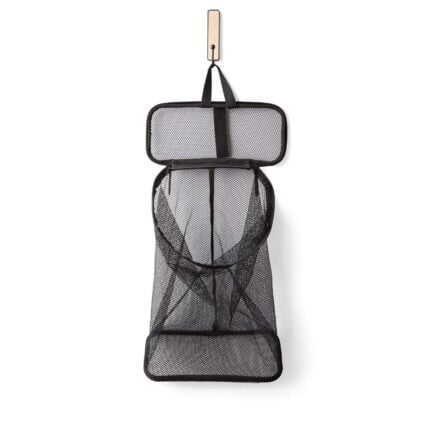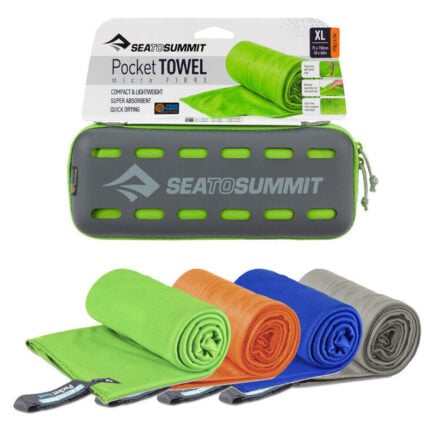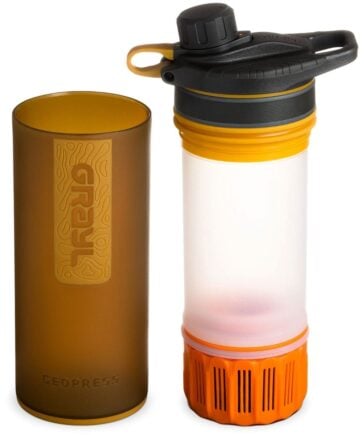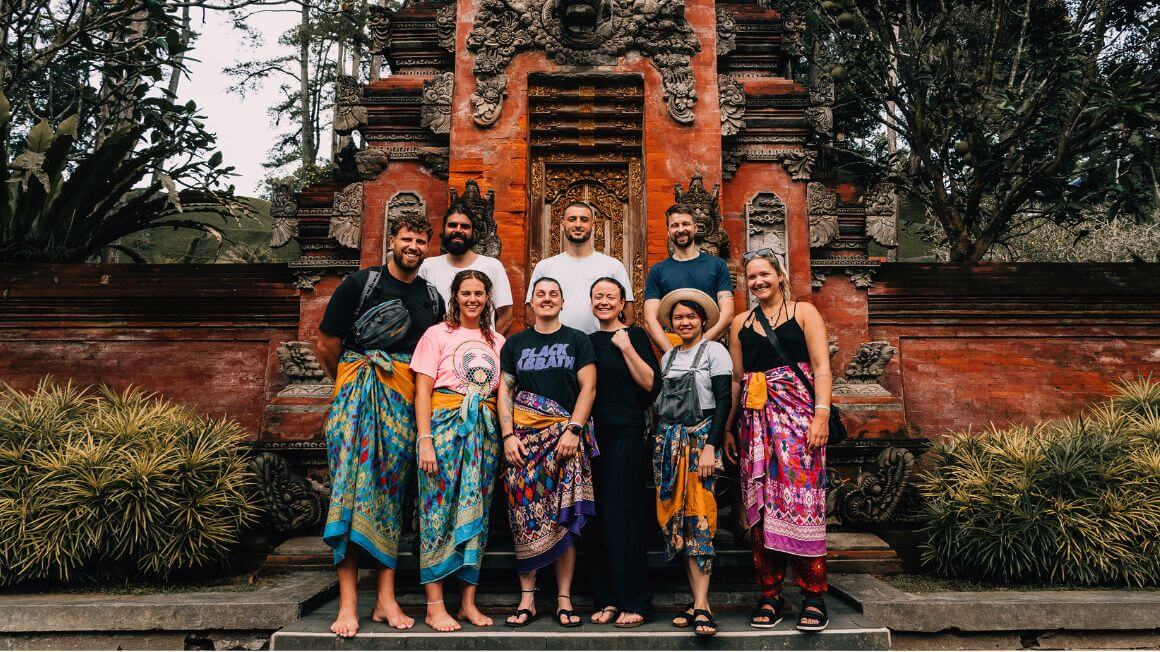The Broke Backpacker is supported by you. Clicking through our links may earn us a small affiliate commission, and that's what allows us to keep producing free content 🙂 Learn more.
As well-traveled the as path is in Mexico, make sure you go off the Gringo trail, get lost…and you’ll find Baja. This peninsula off mainland Mexico is all deserts, cactus-studded hills, and starry, pollution-less nights.
It’s a world away from the resorts and Americanization of Tulum and Cancun.
Thing is, for how magical Baja is, it’s still a bit of a black hole when it comes to solid travel info—especially if you’re backpacking. When I first came to Baja, hostels didn’t even exist. If you wanted to stay on budget, you had to get creative fast.
Thankfully, things have changed.
Baja’s way more accessible for backpackers now, and you can spend your pesos on actually doing stuff—diving, snorkelling, spotting whales and mobula rays in the Sea of Cortez instead of blowing it all on overpriced beds and food made for people who think Taco Bell is authentic Mexican!
Luckily for you I’ve compiled my backpacking Baja guide to give you the 411 on where to crash, what’s actually worth your time, and how to keep it budget without missing out.
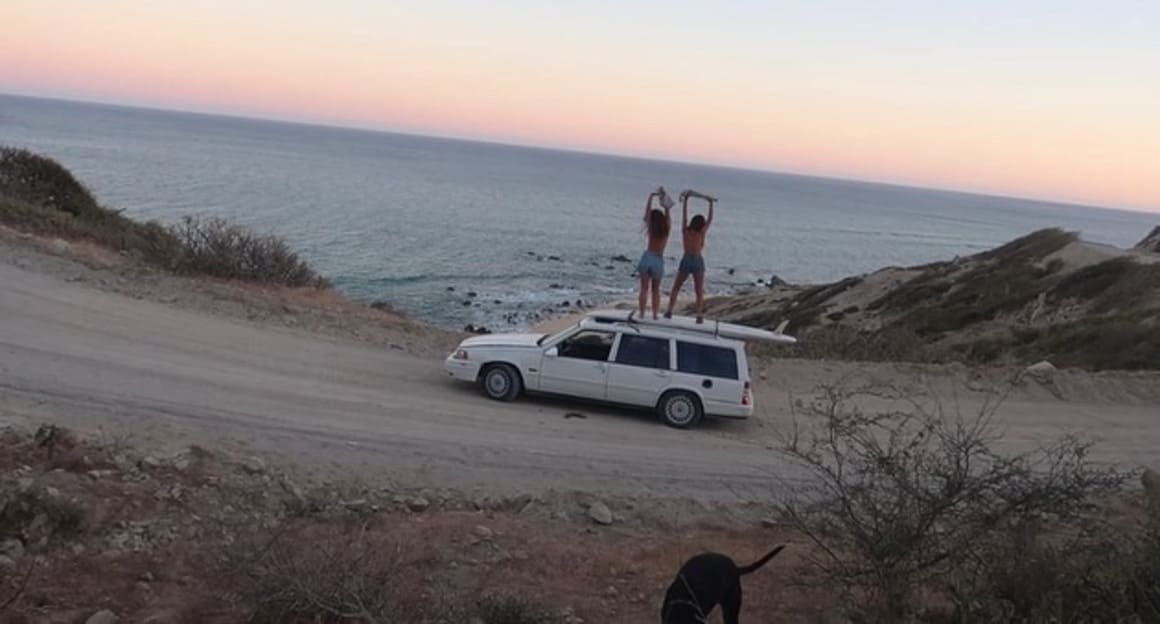
Photo: Audy Scala
The Broke Backpacker is supported by you. Clicking through our links may earn us a small affiliate commission, and that's what allows us to keep producing free content 🙂 Learn more.

Unlock Our GREATEST Travel Secrets!
Sign up for our newsletter and get the best travel tips delivered right to your inbox.
Why Visit Baja
Baja’s the kind of place that doesn’t try to impress you, which is exactly why it does. It’s unfussy, stripped back, and doesn’t need any kind of ornamentation to win you over. That’ll come naturally. You’ll be attracted to Baja if all you’re seeking is the sun, sea, and simple living.
The most insane, unreal ocean encounters are to be had here, whether that be listening to whalesong from a panga in the early hours of the morning, or scuba diving in the most untouched preserved coral reefs you’ll have the privilege of seeing.
If you’re looking for a stripped-back, unpolished side of backpacking Mexico, then this is it. You can live your best Mexican cowboy life here. One minute you’re sipping mezcal in a sleepy cantina, the next you’re swimming with whale sharks or camping on a beach with no reception and no one else for miles.
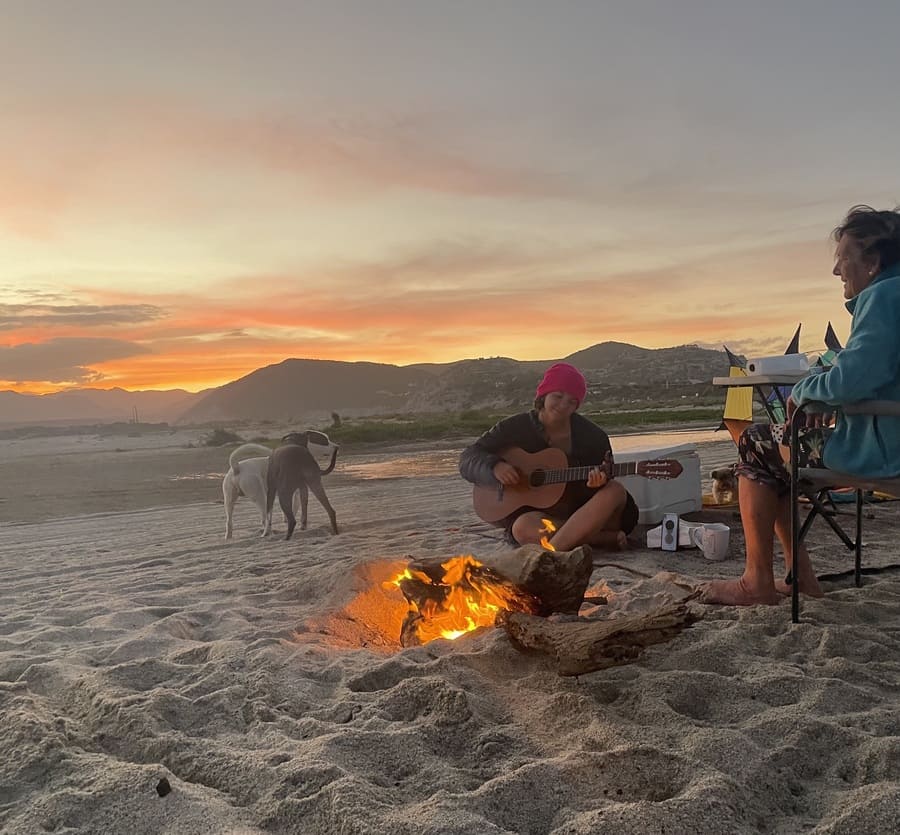
Photo: Audy Scala
The people in Baja are the nicest you will EVER meet, especially when you’re out of the cities—they’re just minding their own business. In other areas of Mexico, especially super touristy areas, you can sometimes feel like just a money bag. But in Baja, the people are just SO CHILL, and you can just blend in, do your own thing, as long as you’re respectful and have a lil Spanish under your belt.
It’s a place where the clocks turn at a different speed. You can get lost, forget time, and fall in love with a bumpy road and an avocado inside a fresh, plain corn tortilla.
Go south until you are alone. Take a paper map. Stay awake late enough to hear the whales breaching or the mobula rays jumping. This is the beauty of Baja.
Best Travel Itineraries for Backpacking Baja
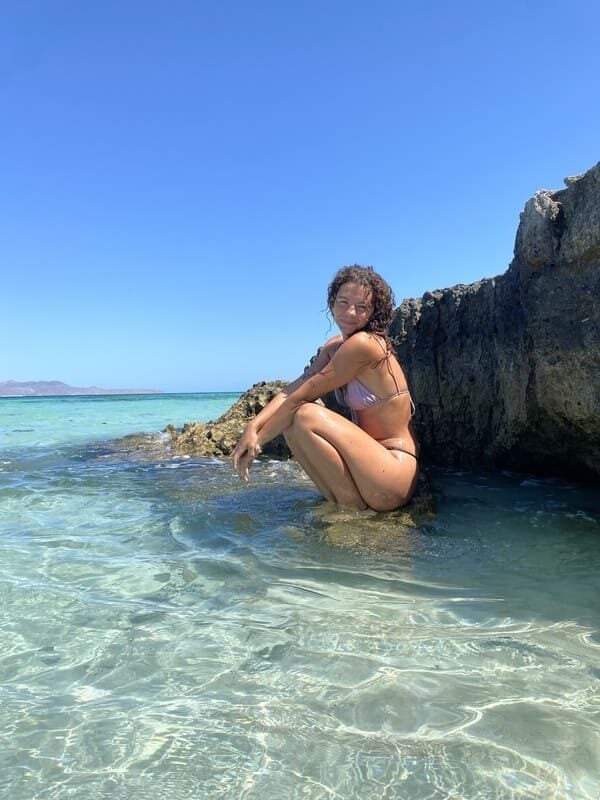
Photo: Audy Scala
Baja is a beast that you could get lost in for months if you wanted to. But I’m going to assume that you’ve got your sights on a couple of different things here, whether that be diving, surfing or living the slow life.
It goes without saying that you won’t cover everywhere, but I’d say you need a week here at the very minimum. 7-14 days will have you sinking your teeth into whatever you have your sights set on. Anything longer than that means you can really slow down…just like this place wants you to.
For all intents and purposes, I’ll just be talking about the south of Baja, Baja California Sur (BCS), and not the northern tip of the peninsula, Baja California. Not confusing at all, right?
The northernmost tourist attraction is Guerro Negro, which straddles the north and south border. This means in this guide, there’s not much to mention beyond that.
Let’s dive into a couple of different itineraries so you can see what suits you.
7-14 day itinerary
No matter why you’re in Baja, you’ll probably be landing in Los Cabos. Whilst it might be more convenient to start in La Paz, unfortunately, that airport tends to serve flights from other Mexican cities rather than the U.S and internationally.
For divers
Land in Los Cabos and hit the road straight to Cabo Pulmo—three hours of dirt roads and dry landscape, but it’s worth every bump. The Wi-Fi is useless, but the diving’s unreal—bull sharks, swirling jacks, and some of the healthiest and most protected reefs in North America. Stay a couple of nights in an off-grid cabana and let the dust and salt settle in.
After a couple of days, wind your way up to La Paz to dive at Los Islotes— here, there are sea lions everywhere who are super curious and want to make new friends. Follow that up with wrecks and reefs, plus a seasonal snorkel with whale sharks or a mobula ray mission if you’re there in late spring.
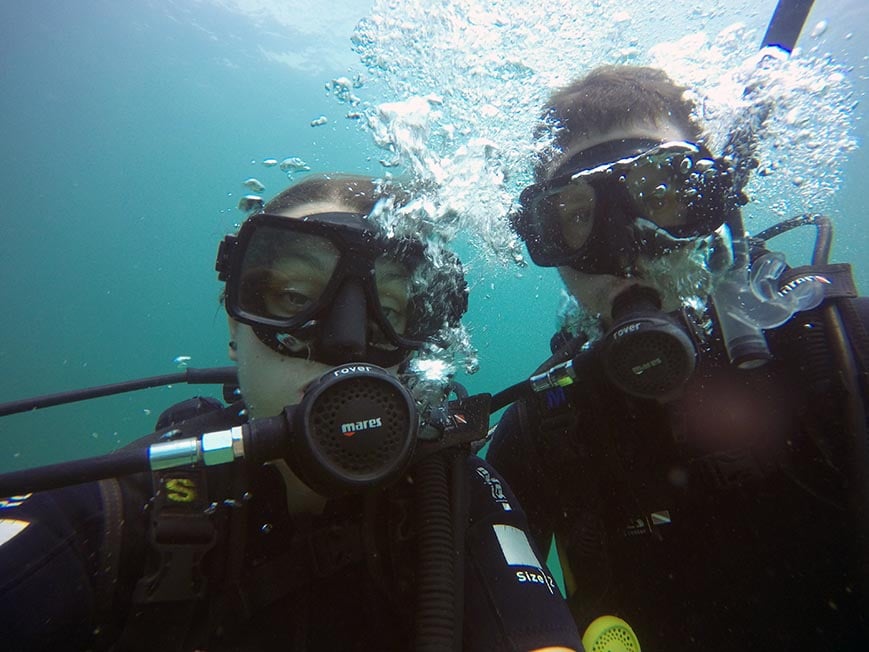
Image: Nic Hilditch-Short.
14+ day itinerary:
If you’re stretching it out, swing by La Ventana for some freediving or wind-chasing, or head to Magdalena Bay in autumn for baitballs and striped marlin. If you finish here, the most convenient place to head out from is Loreto Airport or back to La Paz to catch a flight from there.
Got time and budget to burn? Jump on a liveaboard to the Revillagigedos for the heavy hitters—mantas, dolphins, hammerheads, and long days stretched out on the open ocean. Finish salty, slightly sunburnt, and very satisfied.
For the sport fishers
Fly into Los Cabos and ease in with a relaxed inshore day—roosterfish, jacks, and snapper close to shore with no long runs needed. Early the next morning, head offshore chasing dorado, yellowfin, and the occasional marlin when the season lines up.
Spend a few days working the waters around Cabo, Isla Cerralvo, and the nearby seamounts—bait-rich spots with low pressure and plenty of surprises when the currents cooperate.
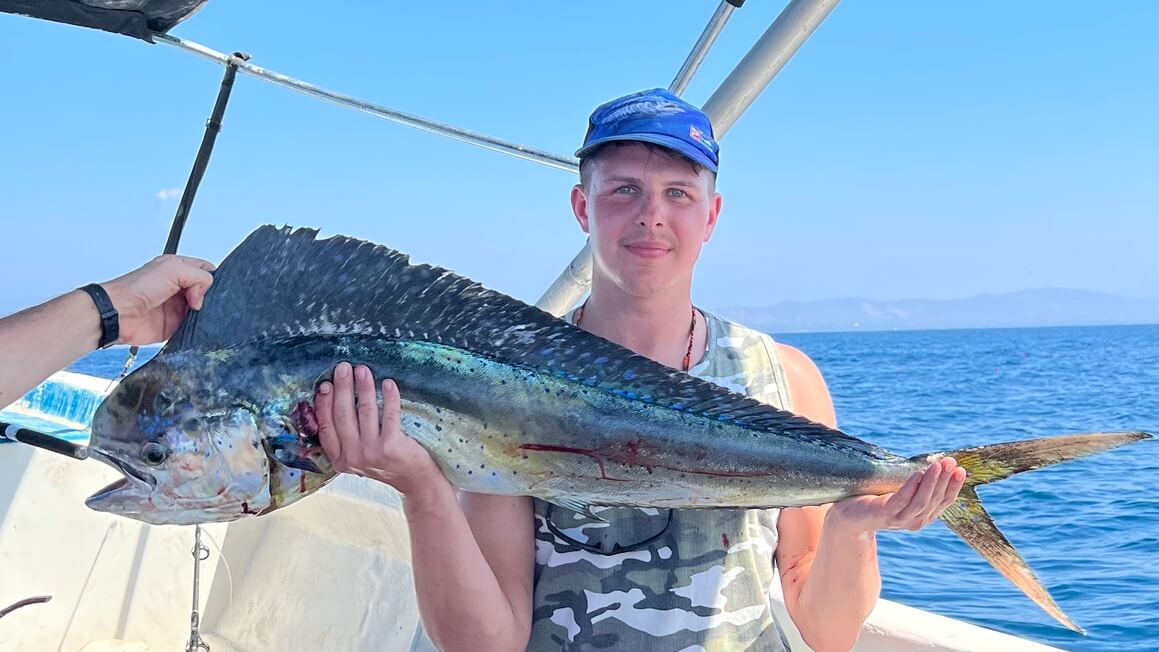
Photo: @joemiddlehurst
Then push east toward Los Barriles or the East Cape, where the boats are dialled in and the big-game fish like striped marlin, sails, wahoo, and tuna are fair game. Choose a basic fishing lodge or a straightforward beachfront spot that caters to early starts and cold beers.
Spend a few days working the waters between La Paz, Isla Cerralvo, and the seamounts—bait-rich, low-pressure, and full of surprises when the current’s right.
14+ day itinerary:
For those with time and budget, multi-day bluewater trips offshore from Cabo offer chances at big tuna, blues, and swordfish. Wrap it in La Paz or back in Cabo, sun “kissed” (ahem, burnt), wind-beaten, and fished out.
The Van-lifers
If you’re heading in from the U.S. border, roll into Baja Sur via Tijuana or Tecate and make your way south down Highway 1, soaking in desert vibes and roadside taco stands along the way.
Pause at Guerrero Negro for a whale-watching break if it’s winter, then keep pushing south through Santa Rosalía with its rusted mining town charm. Camp wild or find quiet beach spots as you cruise toward La Ventana—perfect for wind-chasing or just kicking back on the sand with a cold one.
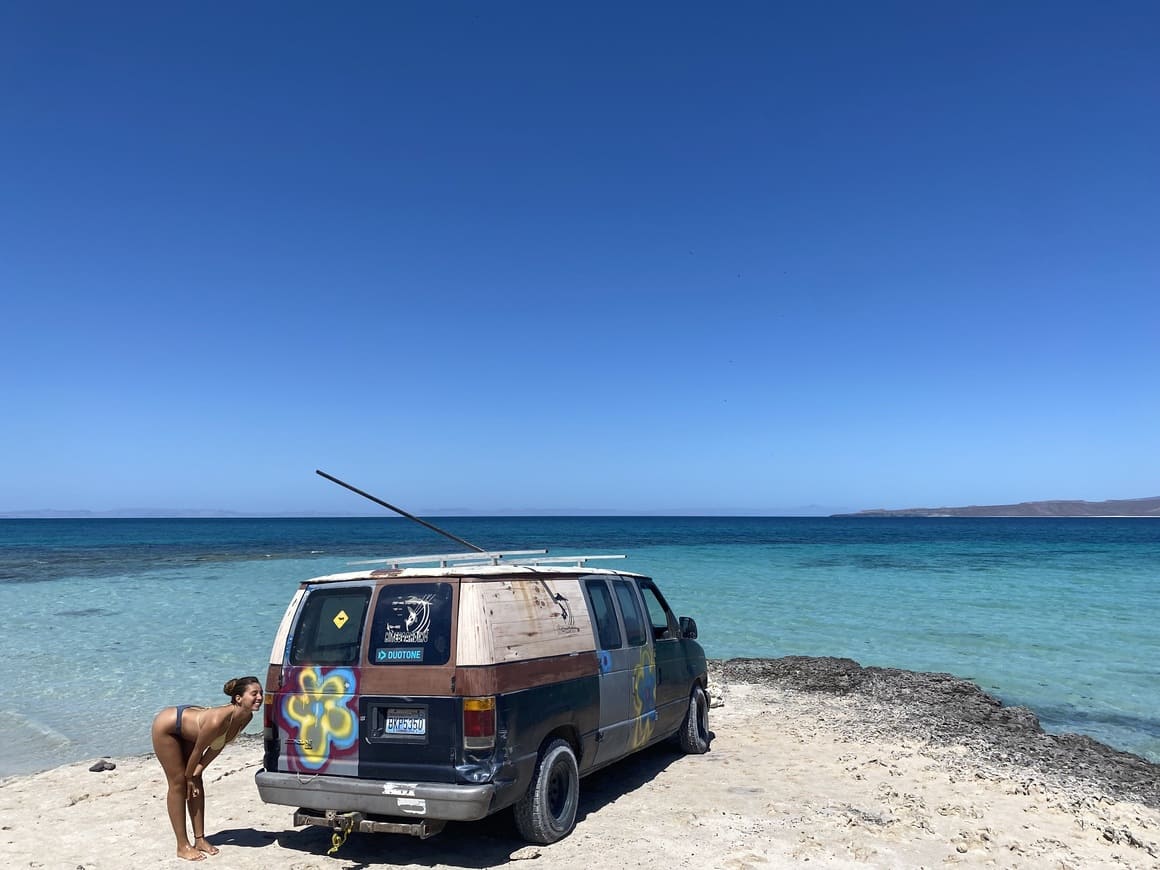
Photo: Audy Scala
Next, swing down to Cabo Pulmo or Los Frailes on the East Cape for some off-grid snorkelling, spearfishing, and nights under the stars without a signal in sight. Head west to La Paz when you need proper groceries, a hot shower, and maybe a night in a hostel to recharge.
14+ day itinerary:
If you’re living the real van life, then corners are less likely to be cut here ie. you’ll probably not want to plan any less than 2 weeks unless you want to be on the road the whole time. Slow it down, factor in travel time, and you could easily watch a month go by here.
If you’re chasing the big migration, loop over to Magdalena Bay in autumn for remote beaches, fishing trips with locals, and that unbeatable Baja quiet. Wrap up wherever the road calls—dusty, with half your gear, and exactly where you want to be.
For those looking for the slow life
If you’re looking for that authentic Mexican charm away from the western tourist towns on the mainland, then Baja is the best of both worlds—low-key resorts with scenery that does the heavy lifting. Fly into Los Cabos and ease in with a few slow days at a quiet resort in San José del Cabo. Wander the art district, swim when you feel like it, and let someone else handle the margaritas and ceviche.
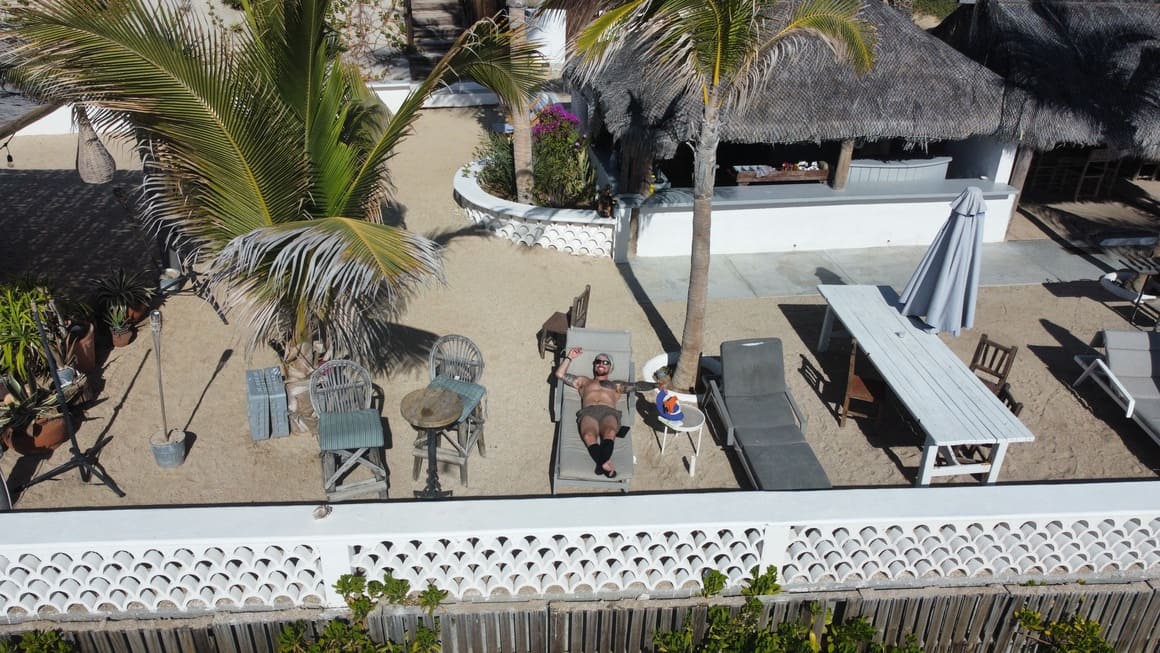
Photo: Audy Scala
Once you’ve fully decompressed, head up to La Paz and check into a waterfront resort or casita. Here, expect calm beaches, long dinners, and the option to do a day trip without needing to.
14+ day itinerary:
If two weeks wasn’t long enough for you to live your best beach bum life, add a few nights at a low-key eco-resort near La Ventana or in the Sierra de la Laguna foothills—somewhere with hammocks, quiet trails, and no pressure to be anywhere. Wrap it back in Los Cabos or La Paz, tanned, rested, and wondering how the days slipped by so fast.
Best Places to Visit in Baja
As you can tell, Baja is quite the beast, and the top sights and sounds are hardly walking distance from one another. Whether you’re here to dive, shred waves or oggle at the ocean and its inhabitants, Baja is your ticket to all things sand and sea.
Backpacking La Paz
La Paz, the capital of Baja California Sur, sits about 2.5 hours north of Cabo San Lucas and hits that sweet spot between laid-back city life and easy access to wild nature. It’s got the creature comforts—good food, walkable streets, waterfront sunsets—without losing that Baja vibe.
From October to April, whale sharks cruise just offshore, and these eco-tours leave right from town, making La Paz a winter magnet for anyone keen to tick these giants off their bucket list. An hour by boat gets you to Los Islotes, where sea lions buzz around you like curious dogs, and nearby dive spots like El Bajo and Espíritu Santo feature some serious pelagic action—hammerheads, schooling fish, and thriving reef.

There’s plenty above water too: freediving, SUP, kayaking, and sailing are all within reach. Inland deserts and quiet coves are an easy day trip, and it’s home to some of the most beautiful beaches in Baja, such as Balandra Beach with its calm and clear waters. The malecón runs the length of town, lined with cafés, shops, and shaded benches to sit and watch the world go by whilst putting a dent in your journal.
Backpacking Cabo San Lucas
At the southern tip of the Baja Peninsula, Cabo is easily accessed by international flights and works well as a jumping-off point. Gordo Banks is the main diving draw—an open-ocean site known for hammerheads and big pelagics. Humpback whale watching runs from December to April, and there’s decent reef diving closer to shore if you’re not heading out deep.
It’s also a solid place to restock gear, plan boat trips, or lean into the nightlife if that’s on the cards. It’s tourist-heavy, no way around that—but if you get out of town, there are still raw corners worth finding.
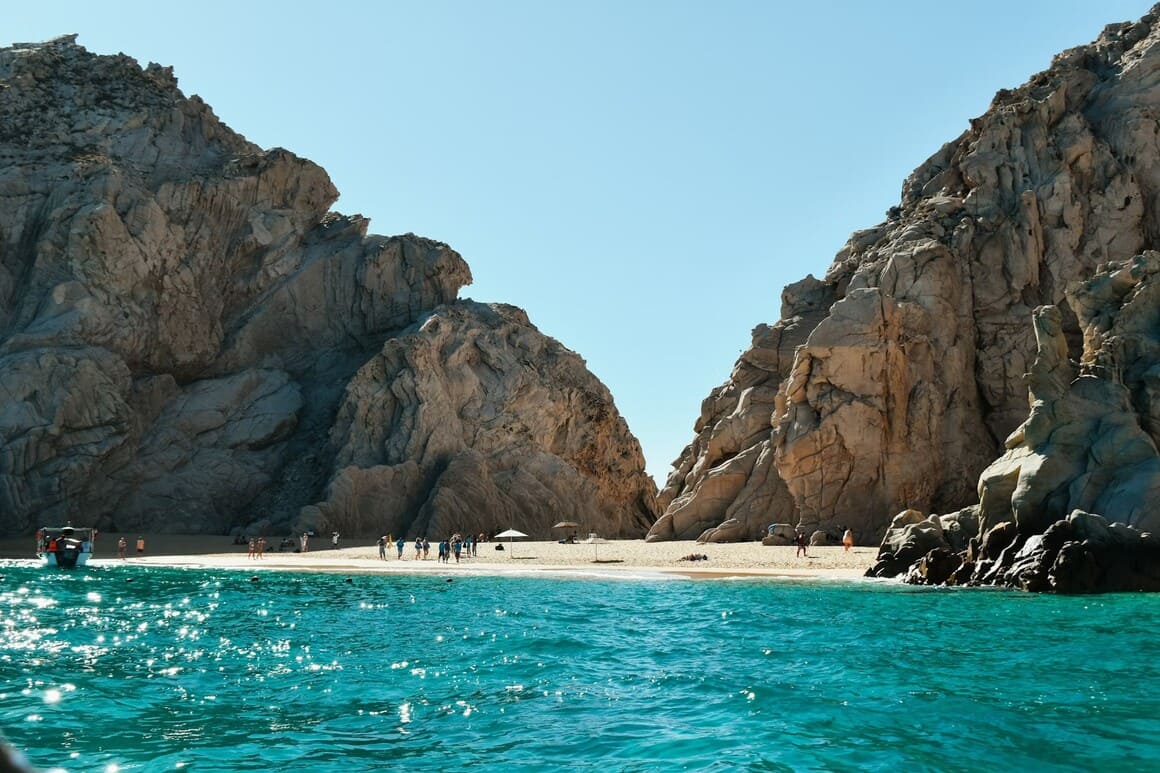
San José del Cabo often gets lumped in with Cabo San Lucas, but they are, in fact, different—San José is quieter, more local, and a better bet if you’re after actual Mexican city life. Head inland and it opens up even more—fewer resorts, more of that “real” Baja magic.
Backpacking Cabo Pulmo
Roughly two hours from Cabo San Lucas, you can reach Cabo Pulmo via La Ribera or a dirt track south of Los Frailes. This is a tiny village tucked up next to a marine reserve—no resorts, just a handful of eco-lodges, dive shops, and dirt roads.
The reef here is one of the healthiest in the Pacific as it’s been fiercely protected by the local community since the ‘90s. Expect massive bait balls, swirling jacks, turtles, reef sharks, and seasonal bull sharks. September to November is prime diving season, with warm water and clear viz. The reef’s shallow enough for snorkelers, too, with vibrant coral and marine life just offshore.
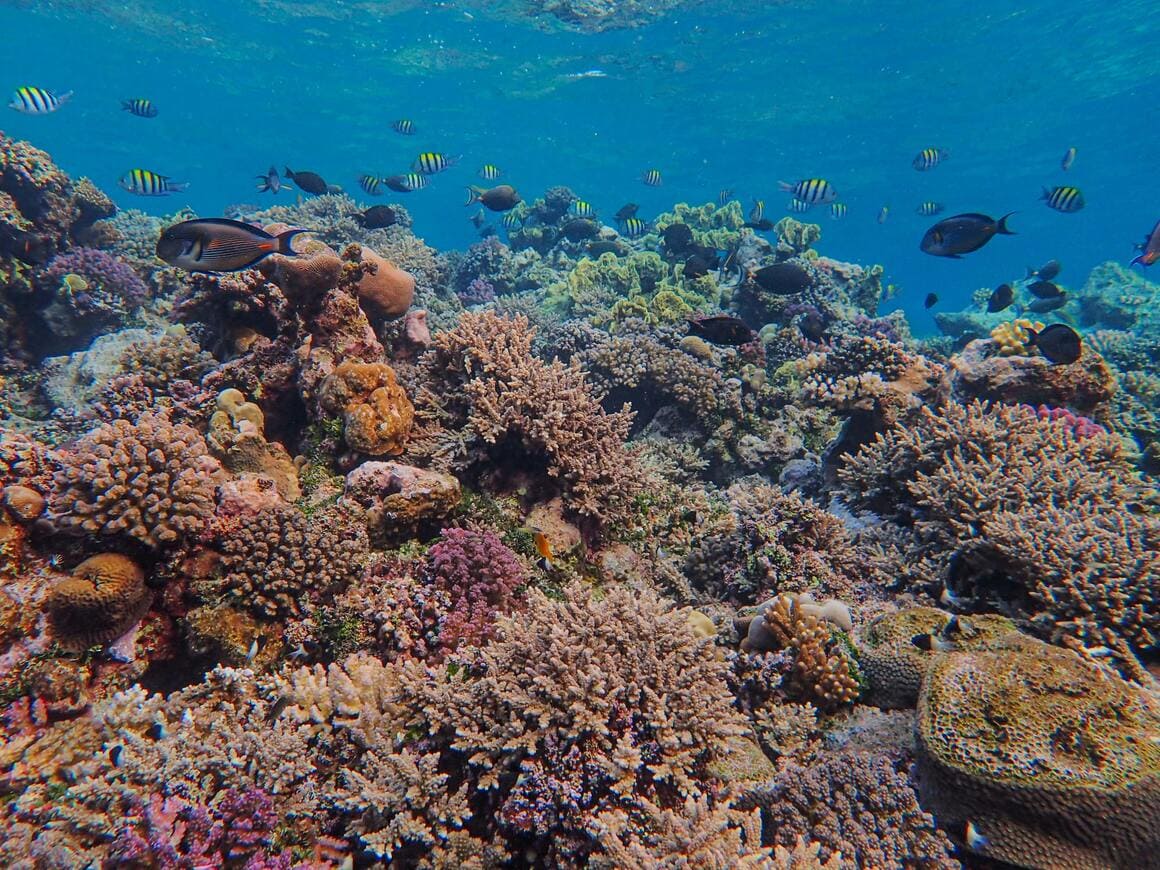
The only downside (well, inconvenience) is that they only allow a certain number of divers at dive sites every day. So every morning they hold a raffle to see who gets the “good” dive sites, and you could get stuck with a more shitty one… Plan to spend many days there to give yourself a better chance to dive at the sites with bull sharks or schooling jacks. This system IS great for conservation and environmental reasons. 🙂
Backpacking La Ventana

Roughly 45 minutes southeast of La Paz and about 2.5 to 3 hours from Cabo by car, this laid-back coastal village sits on the Sea of Cortez side. It’s known for wind sports in winter and marine life in spring and summer, with a seasonal rhythm that draws two very different crowds.
April to July is when the mobula rays show up in full force—thousands of them moving in sync just offshore, perfect for freediving or snorkelling straight from a panga. Dolphins, orcas, and the occasional whale shark also pass through during these months. The water’s clear, the pace is slow, and it’s become a magnet for freedivers, ocean photographers, and anyone chasing a quieter scene.
The town’s still small but steadily growing, with more cafés, eco-lodges, and yoga shacks popping up—it’s quietly becoming Baja’s ‘hip’ zone.
Come winter, the kiteboarders take over (December to March), so expect a totally different vibe depending on when you roll in.
Backpacking Todos Santos
Todos Santos is a chill, artsy surf town that leans more boutique than backpacker, but it’s still doable on a budget if you dig a little. Expect pricier stays near the center, but a few hostels and taco joints keep things manageable.
It’s an easy colectivo ride from La Paz or Cabo, and while it’s not overflowing with nightlife or backpacker buzz, it makes a good breather stop—especially if you’ve been roughing it and want a few days to chill. The vibe is slow, the streets are walkable, and if you’re into surfing or sunsets, you’ll be sorted.
Backpacking Loreto
Loreto is one of the easiest, most relaxed towns in Baja for backpackers—it’s safe, compact, and has just enough going on without being overrun. It’s got a calm waterfront, a walkable historic center, and easy access to islands, desert hikes, and marine parks, all without the hiked prices of the southern tip.

Photo: Audy Scala
Boats head out daily to Isla Coronado or for whale-watching trips, and you can snorkel, kayak, or just swim off the nearby beaches without needing a full tour. It’s also a good place to rent a bike or explore the Sierra de la Giganta if you want to see a bit more of the rugged landscape. Everything moves slowly in Loreto, but that’s half the point.
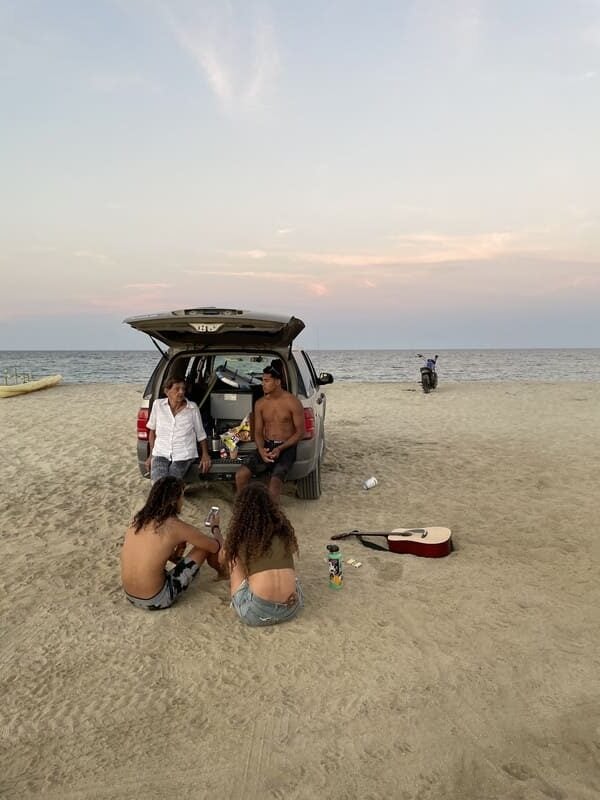
Photo: Audy Scala
Backpacking La Fortuna
La Fortuna is a tiny coastal village between La Paz and Los Barriles, mostly known among surfers and vanlifers looking for peace and waves. It’s remote, quiet, and basic—no real infrastructure, no public transport, and definitely no hostels—so it’s more for self-sufficient travelers or those with a tent or camper setup.
There’s a laid-back beach break, a few eco-lodges, and not much else, which is kind of the appeal. If you’re backpacking and don’t mind being off-grid for a bit, it’s a good place to unplug, surf, and camp under the stars. Just come prepared—there are no shops, and cell signal is spotty at best. Definitely not one for the digital nomads.
Backpacking San Ignacio
San Ignacio is a small, palm-filled oasis town in the middle of the desert—slow, peaceful, and a nice change of pace from the coast. It’s a key stop on the way north or south and popular with backpackers during whale season, when you can take day trips out to see the gray whales in nearby Laguna San Ignacio.
There are a few cheap guesthouses and campgrounds in town, basic food options, and not much nightlife—just a mellow plaza, a mission church, and a laid-back vibe. Remote, but worth the detour—especially if you’re after something quiet and distinctly Baja.
Backpacking Guerrero Negro + Magdalena Bay (separate bays but same vibes)
Tucked away on the Pacific side of Baja near the border of Baja California Sur and Baja Norte, Guerrero Negro is a mission to get to—about 11 hours north of Cabo or 5 from Loreto, the closest airport. But for the wildlife alone, it’s worth every kilometre.
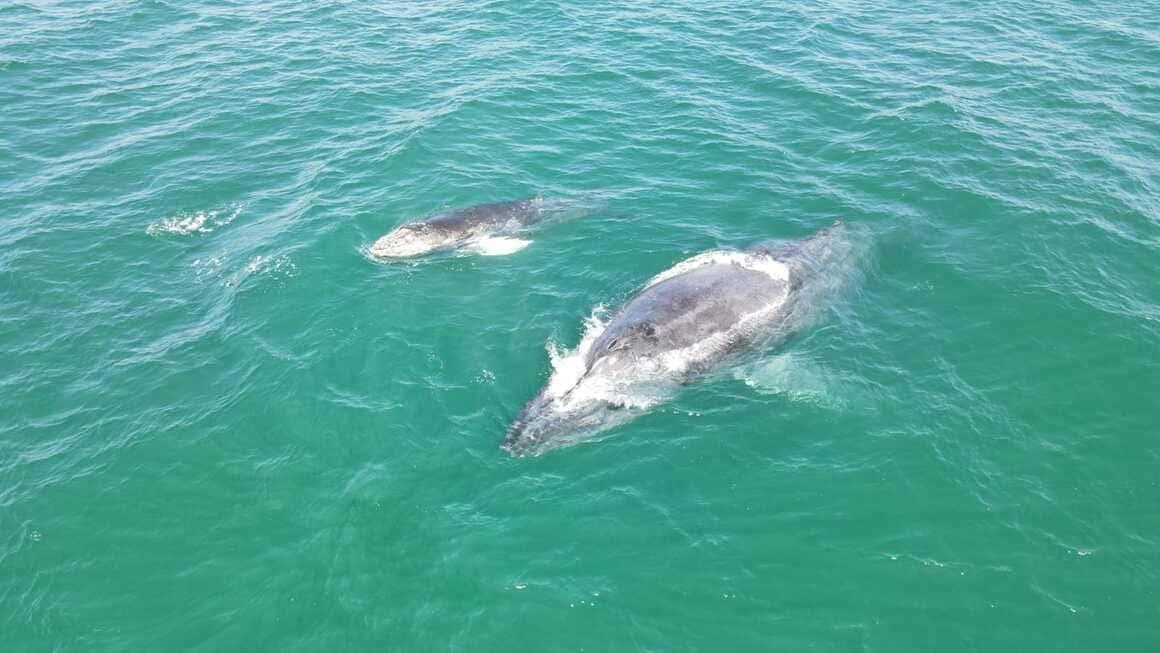
Photo: Audy Scala
From January to March, the gray whale encounters in Ojo de Liebre Lagoon are unreal—this is one of the only places on the planet where the whales actively approach the boats, sometimes close enough to touch. Come summer, there’s the striped marlin sardine run, where you can watch marlins hunt the sardine balls. Add in one of the world’s largest salt flats, some seriously underrated birdwatching, and all of a sudden, you’ve got your nature fix with zero crowds.
The landscape is all desert, dust, and big skies—bare bones, local as anything, and properly remote. Spontaneity doesn’t work well here; you’ll need to plan ahead and book one of the few family-run homestays in advance. If you’re more of a last-minute type, Magdalena Bay might be easier to swing.
Backpacking Bahía de los Ángeles
Backpacking Bahía de los Ángeles drops you right into the raw, remote stretch of the Sea of Cortez—about 8 hours north of La Paz or 6–7 hours south of the US border at Mexicali. From July to September, the warm, calm water draws in whale sharks—slow-moving giants you can snorkel alongside. You’ll also spot mobula rays, sea lions, and pods of dolphins cruising past.
In winter, it turns into a whale-watching zone, with chances to see blue whales and fin whales offshore. There’s not much in the way of infrastructure beyond a small natural history museum and a handful of local spots. If you like your adventures quiet, raw, and far from polished, this place has all three.
Backpacking Ensenada
Backpackers come here for the city comforts, quick access to beaches, hiking, and easy day trips. It’s not the most authentic place in Baja, but it’s a good balance between amenities and a local buzz to keep you ticking over.
Getting around is straightforward thanks to decent public transport, and it’s the launchpad for the Valle de Guadalupe wine region if you’re into that sort of thing.
Getting Off the Beaten Path in Baja
When I was 19, travelling Baja with my friend, we were extremely broke, trying to find a way to explore but not have to pay for hotels. Back in the day, there were no hostels, but they definitely exist now, which is a relief for us broke backpackers!
We bought a hotwired car off a guy for 500 bucks, threw some blankets in the back seat, and called it home. Driving up the coast, we hit hot springs, camped on beaches, and watched whales breach from dusty cliffsides with no one else around.
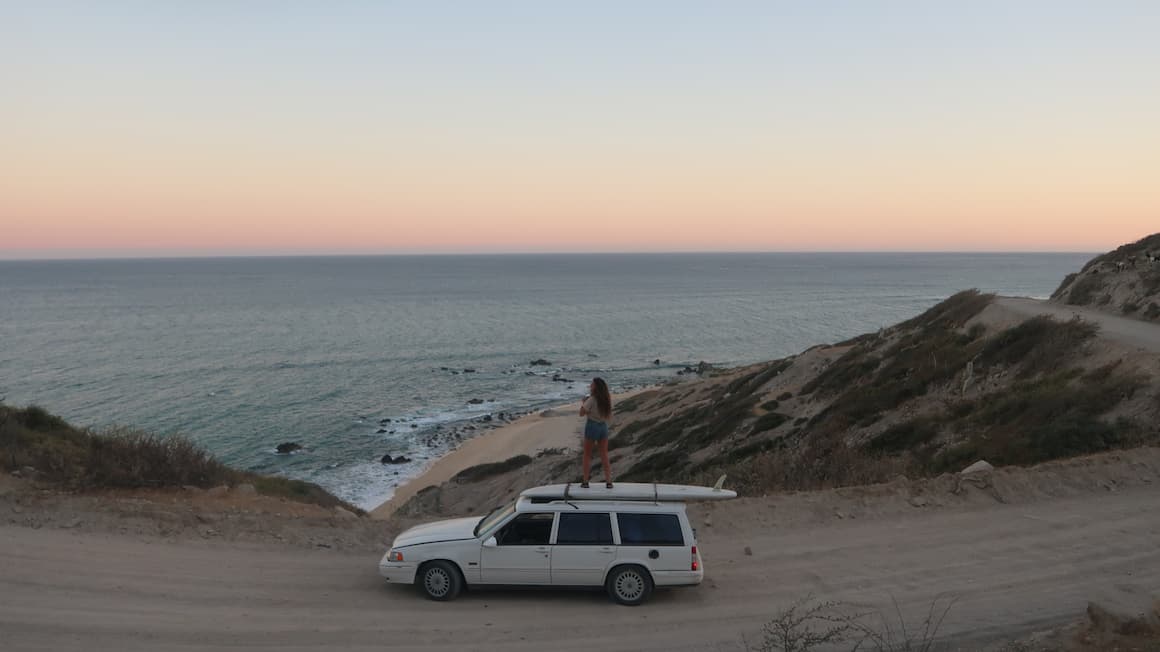
Photo: @amandaadraper
The car had expired plates, so we got pulled over a few times, but let’s just say a $20 handshake and some charm usually did the trick. That’s just how it works down here (if you know you know).
Every spring, loads of wind-chasers head back north and ditch their rigs for cheap, so if you’re lucky and patient, you can find a van or truck setup going for next to nothing. Baja’s full of those sliding-door moments if you hang around long enough. Just be open and trust the universe and your intuition. If you’re open to adventure, you’ll definitely find it in Baja 🙂
Wild camping is legal in most of Baja (unless signed otherwise), and honestly, half the magic is pulling up somewhere with no plan and staying longer than you meant to. Just bring extra fuel, water, and a sense of humour—you’ll need all three when your Google Maps disappears and you’re 20 km deep with a flat tyre and a lukewarm beer. Trust me. Been there.
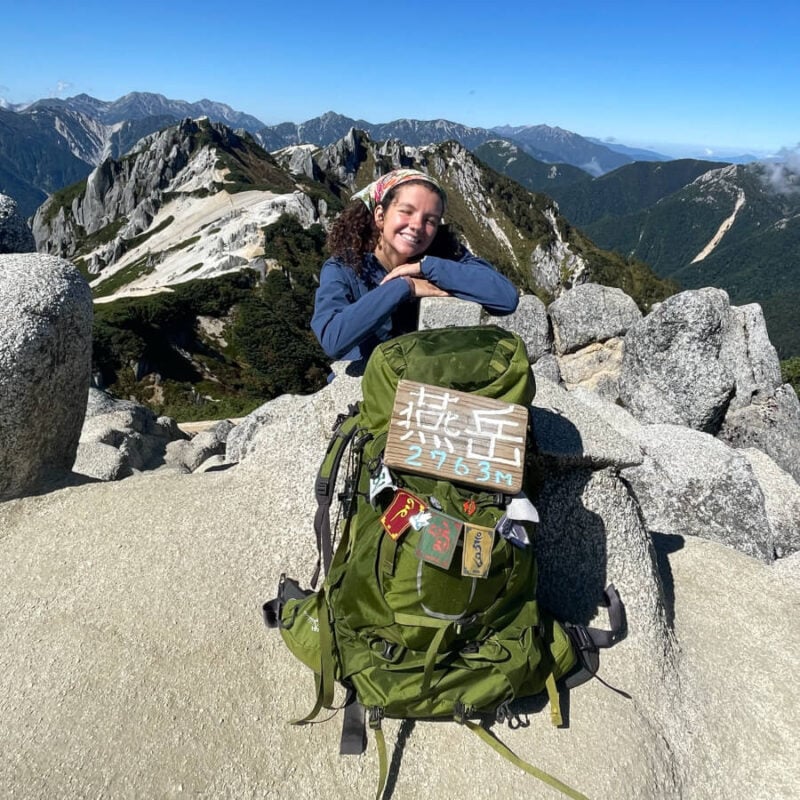
We’ve tested countless backpacks over the years, but there’s one that has always been the best and remains the best buy for adventurers: the broke backpacker-approved Osprey Aether and Ariel series.
Want more deetz on why these packs are so damn perfect? Then read our comprehensive review for the inside scoop!
View on OspreyTop Things To Do in Baja
So you might have already got the gist that Baja is a playground for anyone looking to spend as much time in the ocean as they can. Let’s dive in (literally) to the best things you can do in this Mexican state.
1. Go Diving
Diving in Baja is one of the most insane experiences you can have. Whether you’re all tanks and bubbles or prefer it with just you, your mask, and a pair of fins, there is a literal world underwater waiting to be explored in Baja.
Diving in Baja treats you to a wild mix of marine life and landscapes. Expect to see everything from massive schools of fish and colorful coral reefs to curious sea lions and playful dolphins. From schools of jacks, HUGE groupers, healthy coral, reef sharks, sea turtles, mobula rays, and seasonal humpbacks, the waters in Baja are teeming with life.
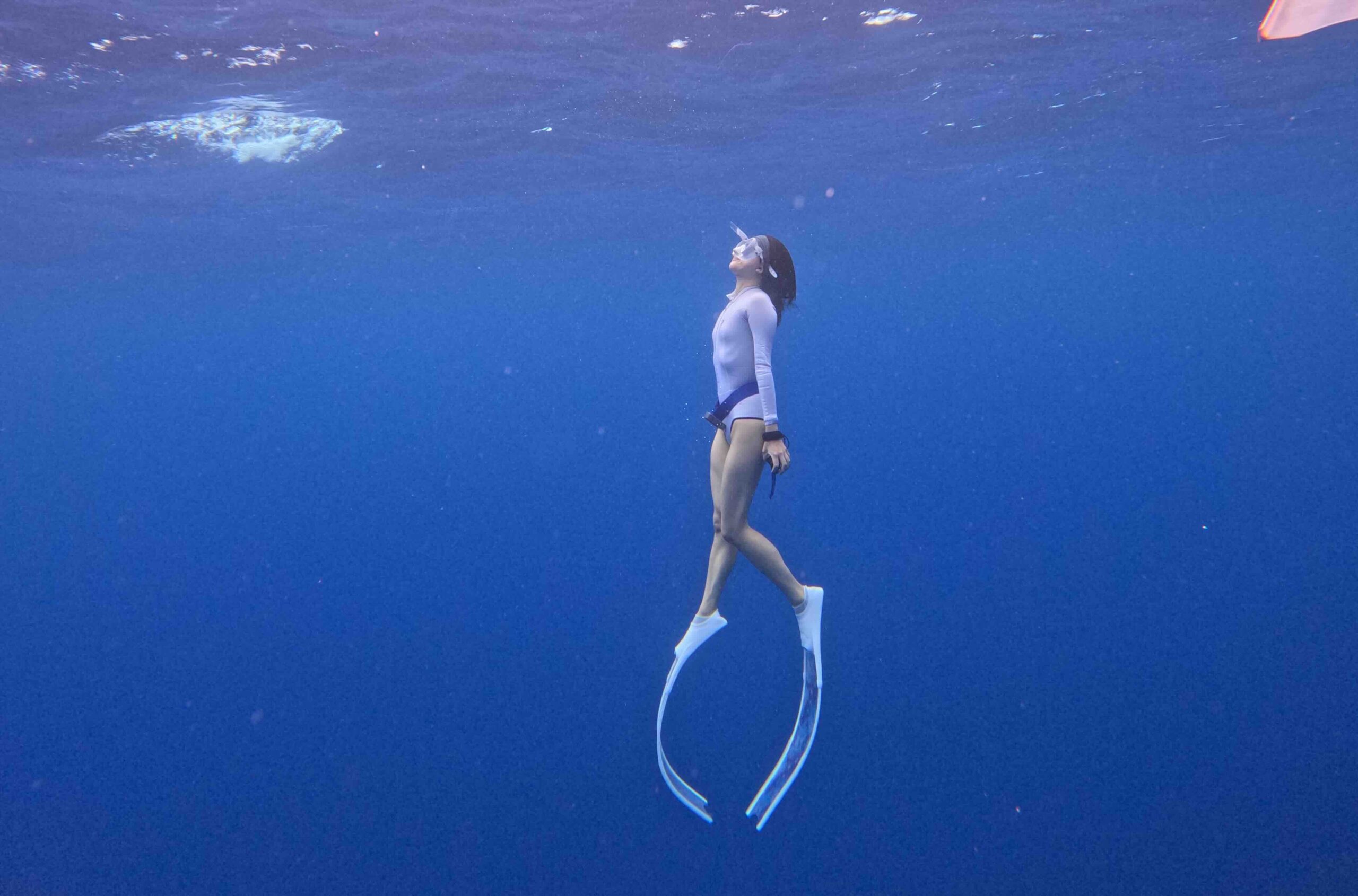
Photo: @audyscala
You can dive pretty much all year round here too, just check for the best times of year if you’re set on spotting certain things like whale sharks or gray whales.
2. Go on a whale watching tour
Baja California is one of the world’s top whale-watching hotspots, with over eight species showing up along its coastlines each year. From gray whales migrating in their thousands to calve in the shallow Pacific lagoons, to blue whales, humpbacks, and orcas cruising the Sea of Cortez—Baja’s waters are full of giants from January to April.

Photo: Audy Scala
Whether it’s friendly gray whales nudging pangas in San Ignacio or humpbacks breaching off La Paz, this stretch of Mexico delivers some of the most up-close, untamed whale encounters you’ll find anywhere. If you’re a real ocean lover, adding whale watching in Baja to your Mexico trip will feel like a pilgrimage you have to do at least once in your life.
3. Watch the mobula ray migration

Every year between May and July, the waters off Baja California Sur come alive with one of the most impressive marine migrations around. Thousands of mobula rays gather in the Sea of Cortez, gliding in huge schools and leaping into the air in a display that’s as strange as it is mesmerising.
During the peak of their migration period, you’ll often see the water erupting as rays launch themselves clear out of the sea, twist in mid-air, and belly-flop back down with a thump that echoes across the bay.
The corridor between La Paz and Cabo San Lucas is your best bet to maximize the sheer number of rays you’ll be able to see. This stretch of the Sea of Cortez is where the real action kicks off—shallow, nutrient-rich, and relatively sheltered, making it prime real estate for massive mobula gatherings.
4. Get your snorkel on
You don’t have to commit to as much as scuba diving in Baja, oftentimes, yourself, a mask and snorkel are good enough! Take yourself down to the coast and follow the water—you’ll be amazed at what you’ll find.
If you want to cover a lot of ground, then joining a snorkel tour is the way to go. They’ll take you to multiple stops throughout the day, plus a bunch will be way off the beaten path, meaning you get the whole reef to yourself. This snorkelling tour includes a hike to a hidden reef to snorkel amongst some of the most VIBRANT marine life in the Sea of Cortez.
5. Spearfish around Isla Cerralvo and the East Cape
Spearfishing around Isla Cerralvo and the East Cape is raw, rewarding, and not for the unprepared. Rocky reefs, drop-offs, and deep blue water hold pargo, cabrilla, and grouper, while offshore you’ve got chances at wahoo, yellowtail, and dorado when the conditions line up.

Photo: @willhatton__
Isla Cerralvo’s south end can get wild with current, but that’s where the big boys pass through. The East Cape is easier to stage from, with local pangas and plenty of dive-friendly coastline.
6. Go visit the sea lion colony
There are a friendly bunch of sea lions that live year-round in the Sea of Cortez, which basically means that you HAVE to swing by and say hello.
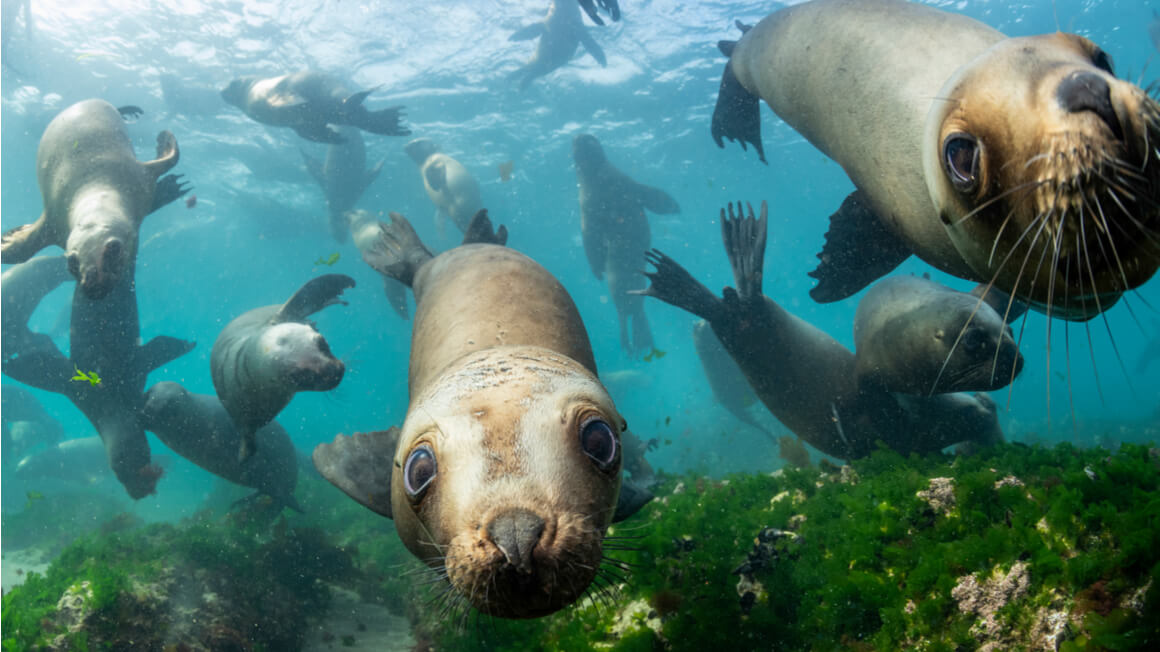
Going on a sea lion tour is your best bet to have a full-day experience. You also get a chance to see mobulas, dolphins in their hundreds (if you’re lucky), along with tons of beautiful fish. The crew makes delicious ceviche and alfajores while you get the chance to lounge on a private beach. Swanky, huh?
7. Kayak Through the Mangroves
Kayaking through Baja’s mangroves means gliding through quiet, tangled waterways where birds and occasional splashes are the only sounds. Places like Magdalena Bay or La Ventana let you drift past thick roots and spot pelicans, herons, maybe even dolphins if you’re lucky. The water’s calm, so it’s easy going, no fancy skills needed.
This tour in La Paz takes all of that one step further by feeding you tons of cool info about the mangrove area and El Mogote. The mangroves you’re taken to are super serene, and the informative guides are just the cherry on top.
8. Wild camp on remote beaches
Wild camping on Baja’s remote beaches is about as raw and free as it gets. Most spots allow it unless clearly posted otherwise, especially along the Sea of Cortez side. You’ll fall asleep to crashing waves, wake up with the sun, and maybe catch dolphins cruising by.
There are no facilities, no signal, and definitely no shops, so bring extra water, food, fuel, and whatever you need to be self-sufficient. It’s dusty, beautiful, and might be exactly what you need.

Photo: Audy Scala
9. Eat your way through Baja’s taco stands
There are a hell of a lot of tacos to get through in Baja. Where do you even start, you ask?! Well, humble taco lover, take the guesswork out of where the best taco stand tucked away is and bow down to the taco master, Axel.
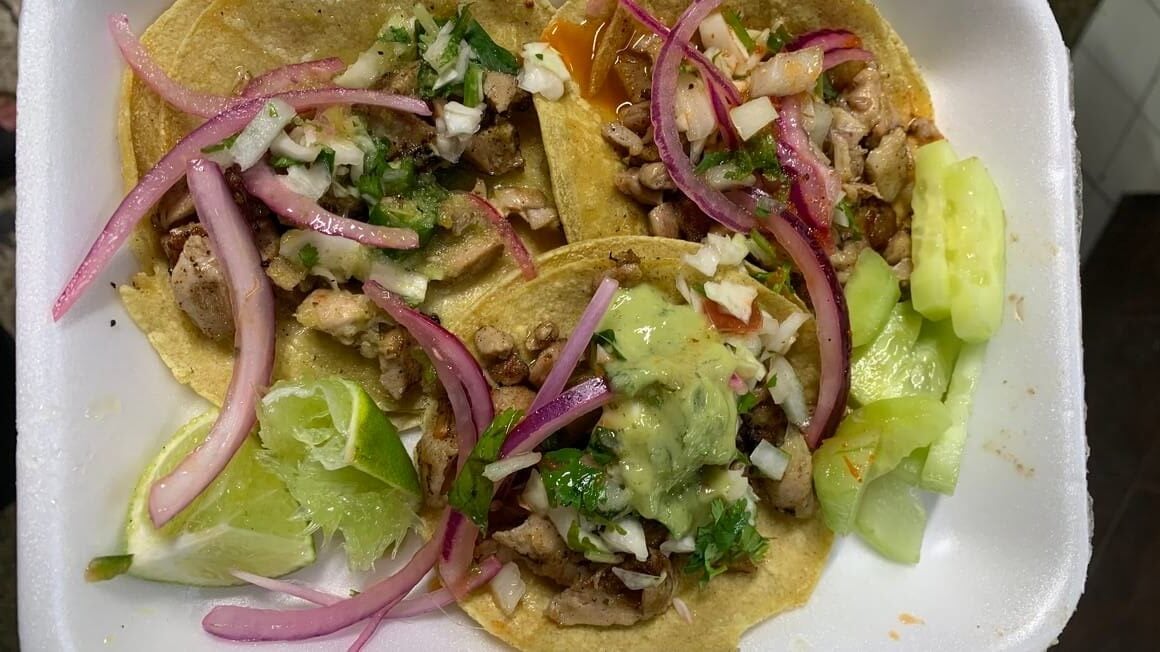
Photo: @joemiddlehurst
This self-proclaimed taco lover takes us mere mortals on his “my love for tacos” tour (Axel is a man of few words, as you can tell), taking you on a whirlwind of tacos, tacos, and you guessed it…more tacos. You’ll uncover hidden spots way off the tourist trail on the hunt for authentic tacos that’ll be etched into memory long after your trip is over.
10. Go off-road
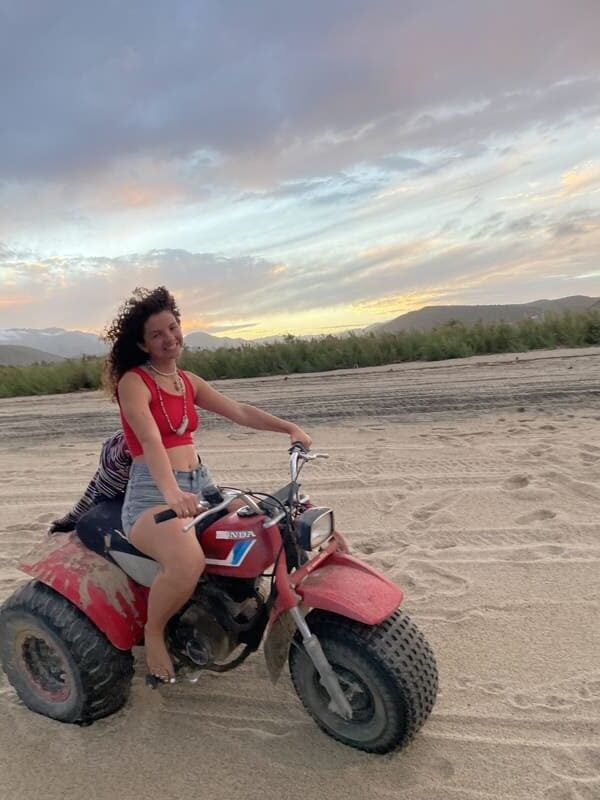
Photo: Audy Scala
Going off-road in Baja unlocks some of the peninsula’s best-kept secrets—desert canyons, isolated coves, and wild campsites you’d never reach on the highway. From the sandy tracks out to Punta Conejo or Scorpion Bay, to the rocky backroads cutting across the Sierra de la Giganta, you’ll hit terrain that’s barely marked on maps.
A proper 4×4 gets you to places like San Francisquito, Agua Verde, or the remote missions tucked into the hills. Expect river crossings, washboard roads, and long stretches without service—bring recovery gear, extra fuel, and a decent sense of direction. Baja rewards the stubborn.
If you don’t want to go that hardcore, then you can always hire an ATV or go on a tour to tear up the desert for the day. Same same, right?

Wanna know how to pack like a pro? Well for a start you need the right gear….
These are packing cubes for the globetrotters and compression sacks for the real adventurers – these babies are a traveller’s best kept secret. They organise yo’ packing and minimise volume too so you can pack MORE.
Or, y’know… you can stick to just chucking it all in your backpack…
Get Yours Here Read Our ReviewBackpacker Accommodation in Baja
As I said, back in the day when I first discovered Baja, there was no infrastructure for backpackers to visit easily if you were keeping to a strict budget. That meant wild camping, van lifing, and couchsurfing if you struck lucky. Fortunately, tourism development in Baja means that that’s now all changed. Sure, you won’t see the swarms of backpackers flocking to hostels like you do in mainland Mexico, but at least they exist now.

Photo: Audy Scala
Of course, you can expect to find these hostels in the main hubs like Cabo and La Paz, for more rural spots, expect to book a homestay or set up camp on the beach to keep costs down.
For something with a bit more soul than your standard stay, check out The Baja Station in La Fortuna. It’s an off-grid community run by friends of mine, built around slow travel and meaningful connection. Think underwater sound meditation, sailing trips, a recording studio, and whale watching tours—all run by Gio, a marine biologist who studies underwater acoustics and marine mammal communication. If you’re a backpacker looking for a bit of soul in your stay, this is the place you’ll find it.
Best Places to Stay in Baja
| Destination | Why Visit | Best Private Stay |
|---|---|---|
| La Paz | Offers the best mix of adventure and comfort—a walkable waterfront city with direct access to nature. La Paz is also a great home base to explore inland deserts or do day trips to beaches like Balandra (voted most beautiful beach in mexico). | Hotel & Suites El Moro |
| Cabo San Lucas | It’s flashier than the rest of Baja, but if you want sun, surf, and a party with your scenery, this is where it all collides. Tourist-heavy but still has pockets of raw beauty nearby, especially if you head out of town. | Solmar Resort |
| Cabo Pulmo | A tiny village next to a marine reserve—no big hotels, just a handful of eco-lodges and dive shops. One of the healthiest coral reefs in the Pacific, protected by the local community since the 90s. | Bungalows Cabo Pulmo |
| La Ventana | A laid-back coastal village known for wind sports in winter and marine life in spring/summer. The town is small but has a growing number of cafés, eco-lodges, and yoga spots, becoming the ‘hip” area of Baja. | ChangoMango |
| Todos Santos | You’d visit Todos Santos for its laid-back surf scene and the chance to soak up a quieter, artsy side of Baja away from the crowds. It’s got local art, a decent reef break and a quiet vibe that other bigger hubs can’t say the same for. | Baja Temple |
| Loreto | Loreto is known for its easygoing vibe, cheap seafood, and access to some of the best nature in Baja without needing a tour group to hold your hand. | Hotel 1697 Loreto |
| La Fortuna | If you’ve got your own wheels and want to disappear for a bit, La Fortuna is the spot for you—surf all day, camp under the stars, and forget cities exist. | The Baja Station |
| San Ignacio | This is all about desert oasis vibes. Come whale season, you can head out to Laguna San Ignacio for up-close encounters with gray whales, or stay inland and explore ancient cave paintings and desert trails. | Rancho Espinoza |
| Guerrero Negro + Magdalena Bay | Guerrero Negro and Magdalena Bay serve up surreal salt flats, remote beaches, and some of the best gray whale encounters on the planet. It’s Baja at its wildest—quiet, rugged, and full of that stripped-back magic you only get far from the main hubs. | Hotel Los Caracoles |
| Bahía de los Ángeles | Bahía de los Ángeles is a dusty little fishing town with calm, clear water, a couple of tiendas, and just enough infrastructure to keep you fed and afloat. It’s a good stop for snorkeling, kayaking, and spotting whale sharks in season, with a slow pace and very few crowds. | Los Vientos Hotel |
| Ensenada | Ensenada is an easy stop for backpackers chasing waves, looking to eat well, or heading inland to the Valle de Guadalupe without paying Cabo prices. | La Villa de Adelina |
Baja Backpacking Costs
If you’re figuring out where to stay in Mexico, you gotta know that backpacking Baja generally costs more than mainland Mexico. ESPECIALLY if you’re used to cheap buses, hostels, and street eats further south. Accommodation in Baja runs higher—basic rooms or dorms are often $5–10 USD more per night compared to places like Oaxaca or Chiapas, and hostels are fewer and farther between, especially in the north.
Saying that, backpacking Baja can be surprisingly affordable if you’re willing to keep things simple. Street food, humble homestays, and free activities can keep your budget running for a while. It’s all about what you’re willing to splurge on.
Here is a breakdown of the costs involved with backpacking in Baja:
Budget hostels or basic guesthouses run about $15–30 USD a night in places like La Paz or Loreto, though smaller towns might only offer budget hotels for $25–40.
Camping is common and often the best bet for budget travelers—some beaches let you pitch a tent for free, while others ask for a small fee or expect you to eat at their palapa restaurant. Alternatively, people sleep in their cars or vans without much hassle.
Booking platforms don’t always show the full picture, either—some of the cheaper spots aren’t online, so asking around on arrival still works, especially in quieter towns.
For backpackers in Baja, food’s one of the easiest things to keep cheap without sacrificing quality.
Tacos are everywhere, usually $1–2 USD each, and you’ll never be far from a stand grilling up carne asada, fish, or shrimp, especially near the coast. You can easily live off these, with the occasional splurge on a seafood plate or coctel when you’re feeling flush.
Self-catering is doable but not always worth the effort unless you’re camping or road-tripping with a cooler. Grocery stores and markets sell the basics, but communal kitchens are rare unless you’re in a hostel.
Getting around Baja takes a bit more planning than on the mainland, but it’s doable if you’re patient and not expecting rock-bottom prices.
Long-distance buses like ABC and Aguila connect most of the major towns—Tijuana, Ensenada, Guerrero Negro, Loreto, La Paz, and Cabo—with fares ranging from $15–50 USD depending on the distance.
The buses are clean and reliable, but there’s usually only one or two departures a day, and booking ahead is smart in high season.
Local transport’s where it gets sparse. Colectivos and second-class buses are rare outside of bigger towns, so shorter hops can get tricky.
Hitchhiking is fairly common among travellers, especially in the northern stretches, and while it’s not guaranteed, it’s usually safe and fairly well accepted.
Car rentals open up way more freedom, especially for beach hopping or exploring the backroads, but fuel’s pricey and solo travelers will feel the cost fast.
Some backpackers link up and split rentals or ride with vanlifers heading the same way.
This’ll be where your main costs add up, and for good reason. If you’re traveling down to Baja, don’t you DARE scrimp on all of the insane things there is to see and do here. Why else would you be here?!
Activities in Baja swing between totally free and budget-busting, depending on how much gear or guiding you need.
The good news is, if you’re into beaches, hiking, or just kicking around quiet towns, there’s plenty to do without spending much—most beaches are free access, wild camping spots are everywhere, and hikes through desert hills or cactus-covered coastlines cost nothing.
But once you get into tours—whale sharks in La Paz, whale watching in Guerrero Negro or Magdalena Bay, kayaking around Espiritu Santo, or diving in Cabo Pulmo—the prices jump fast.
Expect to pay $50–100 USD for most guided trips, more for multi-day stuff. Worth it if you’ve got the cash, but easy to blow your budget if you’re saying yes to everything.
And what would a trip to Baja be without some diving? A two-tank dive usually runs $100–140 USD, depending on the shop and season, and gear rental’s often included.
If you’re on a tight budget, it’s not the cheapest place to dive, but the marine life makes it worth saving up for.
Money in Baja
Money in Baja is a bit more annoying to manage than in mainland Mexico, especially for backpackers trying to stretch their pesos. ATMs can be unreliable in smaller towns—they either run out of cash, don’t work with foreign cards, or hit you with steep fees. It’s smart to pull out extra when you’re in bigger places like La Paz, Loreto, or Ensenada and stash some pesos for the stretches in between.
Cash is king pretty much everywhere outside the touristy south. Most taquerías, colectivos, budget hotels, and beach vendors won’t take cards, and some places won’t even have change for big bills. Some hostels and tours take cards, but expect a markup or a “machine’s not working” excuse as they don’t want to pay for the fees.
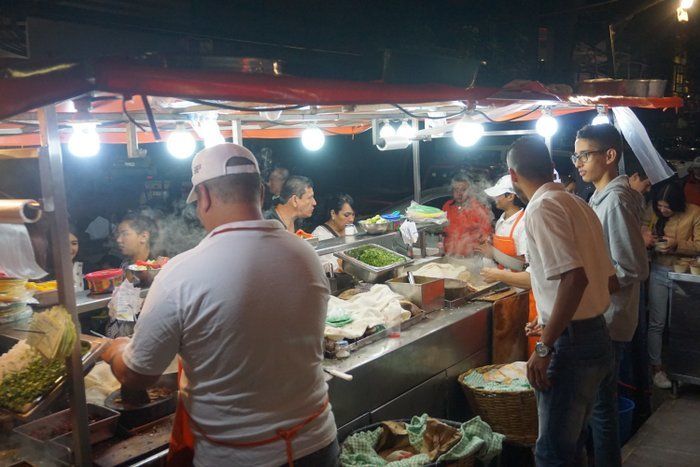
The official currency in Baja is the Mexican peso (MXN). While US dollars are accepted in some touristy areas—especially in Baja California (north of Guerrero Negro) and places like Cabo San Lucas or La Paz—you’ll almost always get a worse exchange rate if you pay in dollars. Local prices are listed in pesos, and smaller towns, street vendors, colectivos, and most budget accommodation expect pesos only.
Best bet: carry pesos, use ATMs in bigger towns when you can, and avoid relying on dollars unless you’re stuck or paying for something tourist-priced.
For all matters of finance and accounting on the road, The Broke Backpacker strongly recommends Wise – The Artist Formerly Known as Transferwise! Our favourite online platform for holding funds, transferring money, and even paying for goods, Wise is a 100% FREE platform with considerably lower fees than PayPal or traditional banks.
And yes, it’s even better than Western Union!
Top Tips for Visiting Baja on a Budget
To keep your spending to an absolute minimum whilst travelling in Baja, I recommend sticking to the basic rules of budget backpacking…
- Always carry cash: ATMs are unreliable and card payments aren’t a given, especially in small towns.
- Eat where locals eat – Some of the best street tacos and loncherías in Mexico keep you full without draining your wallet.
- Pick your splurges – Whale sharks, diving, and whale watching are amazing, but pricey—don’t try to do everything if you don’t have the budget for it.
- Camp or hostel-hop – Camping is free or cheap in lots of places, and basic hostels do the job in La Paz, Loreto, and Ensenada.
- Hitch or rideshare if you’re stuck – Especially between remote towns where buses are sparse.
- Bring snorkel gear if you have it – Cuts out rental costs and opens up free fun all over the coast.
- Watch the ferry costs – If you’re crossing to/from mainland Mexico, compare prices early and book in advance.
- Learn some Spanish – the locals will greatly appreciate it, plus it might pull you out of any sketchy situations you might happen to find yourself in.
Why Should You Travel to Baja with a Water Bottle?
Plastic washes up on even the most pristine beaches… So do your part and keep Baja beautiful!!
You aren’t going to save the world overnight, but you might as well be part of the solution and not the problem. When you travel to some of the world’s most remote places, you come to realise the full extent of the plastic problem. And I hope you become more inspired to continue being a responsible traveller.
Plus, now you won’t be buying overpriced bottles of water from the supermarkets either! Travel with a filtered water bottle instead and never waste a cent nor a turtle’s life again.
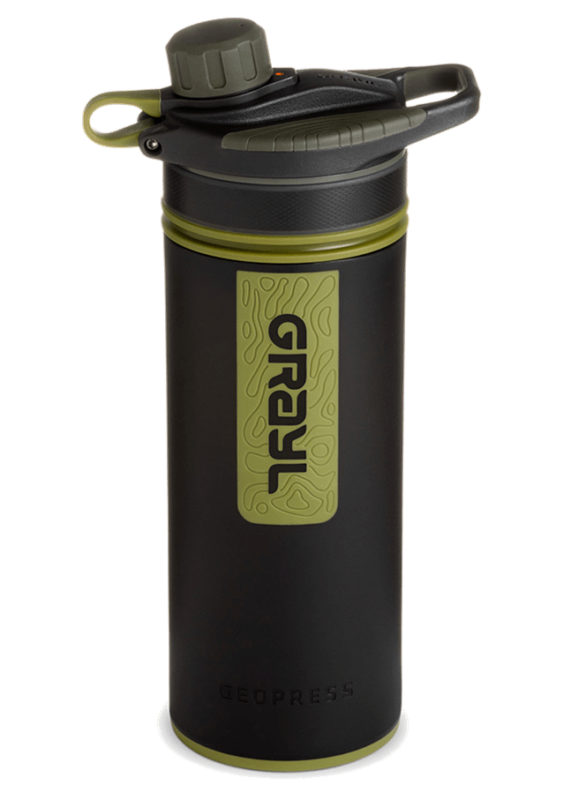
Drink water from ANYWHERE. The Grayl Geopress is the worlds leading filtered water bottle protecting you from all manner of waterborne nasties.
Single-use plastic bottles are a MASSIVE threat to marine life. Be a part of the solution and travel with a filter water bottle. Save money and the environment!
We’ve tested the Geopress rigorously from the icy heights of Pakistan to the tropical jungles of Bali, and can confirm: it’s the best water bottle you’ll ever buy!
View on REI Read the ReviewAnd Speaking of Plastic… Get an eSIM for Baja
You know those tiny pieces of plastic you used to use to connect yourself to the internet abroad? Sim Cards, I think they were called? Well, yeah, we’re ditching those as well.

These days, wherever you go in the world, an eSIM is by far the best way to stay connected from the minute you land. You can download an eSim before you leave home and then activate it when you are still sitting on the plane waiting to disembark.
You skip all the hassle of trying to figure out different providers and navigating airport prices to make sure you’re not getting scammed.
Of all the many eSim providers out there, we suggest Jetpac. Jetpac works just like an app: you download it, pick your plan, and BOOM! You’re connected before the pilot says you can stand up.
Best Time to Visit Baja
Baja’s not a one-season-fits-all kind of place. When to go really depends on what you’re showing up for and how much heat, wind, or tourist traffic you’re willing to deal with. Not to mention how many pesos you’re willing to burn through.
You might be here for a myriad of reasons, or maybe you just want to do some reaaaaaally fucking awesome diving. Both are cool. Here’s a deep dive into the best times to visit Baja, depending on what floats your boat.
Whale Season (January to March)
This is the big one. Gray whales migrate down from Alaska and gather in the lagoons along the Pacific coast—places like San Ignacio, Guerrero Negro, and Magdalena Bay. If you want close encounters from a small boat, this is the time. Towns fill up, but it’s worth it. You’ve also got a shot at seeing humpbacks and even blue whales if you’re diving or boating near Loreto or La Paz.
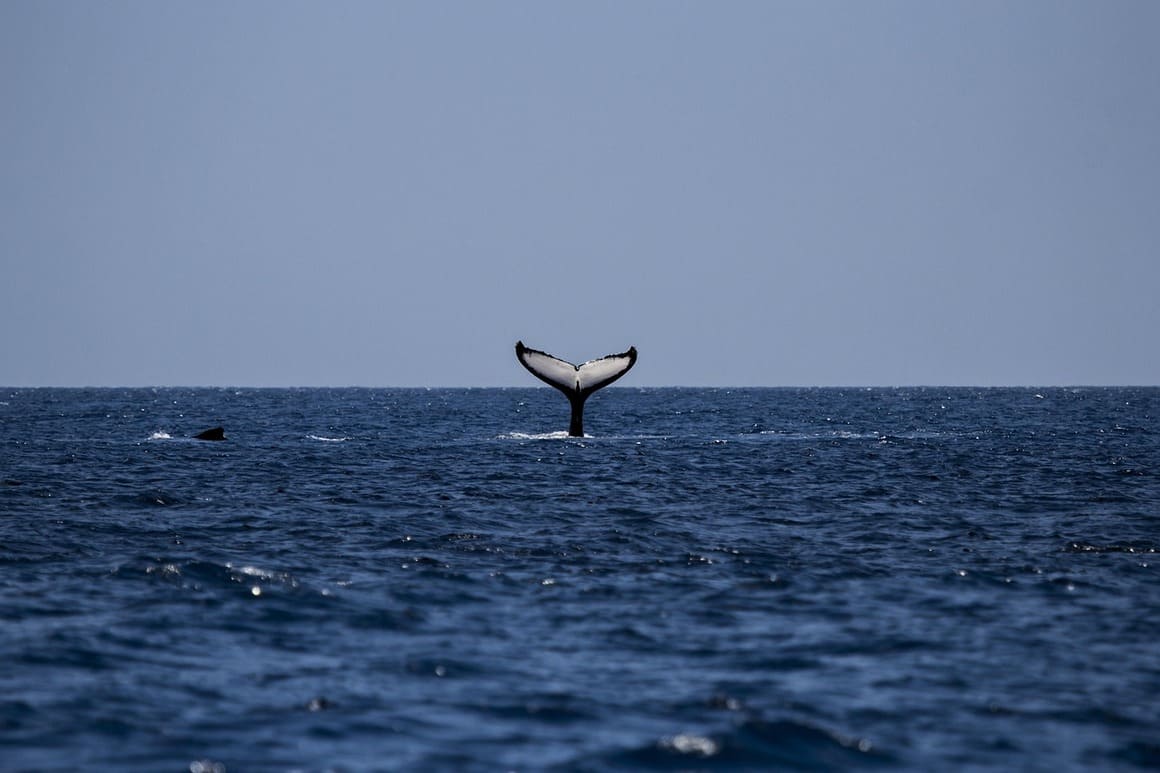
Diving & Snorkeling (October to November)
This is when you’ll see the Sea of Cortez in all its glory. The water’s warm, visibility is excellent, and marine life is everywhere. Whether you want to spot sea lions, rays, turtles, or whale sharks, you’ll get a fighting chance this time of year here. La Paz, Loreto, Cabo Pulmo, and even the islands near Bahía de los Ángeles are all at their best now. You can dive year-round in the south of Baja, but this window gives you the sweet spot before winter winds kick up.
Surf Season (November to March)
The Pacific coast gets solid winter swell, especially around Todos Santos, Cerritos, and San Juanico. The morning breaks are usually clean, the crowds are manageable, and the weather stays mild enough that you won’t be freezing your ass off in a wetsuit. Summer gets smaller, inconsistent waves, but the Sea of Cortez side (like Nine Palms) starts working when hurricanes kick up south swell.
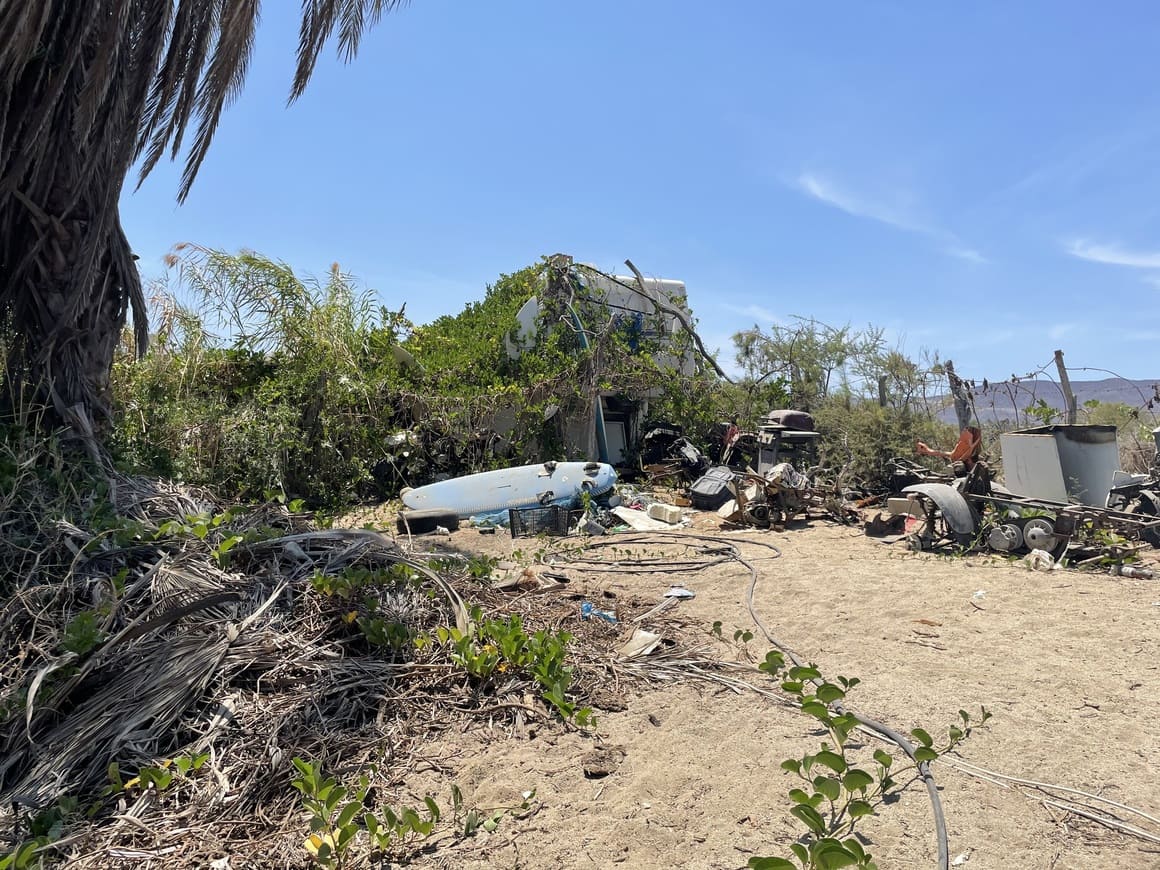
Photo: Audy Scala
Hiking & Inland Travel (November to April)
If you’re heading into the desert, doing multi-day hikes, or planning road trips through central Baja, cooler months are your friend. Summer in places like San Ignacio or Mulegé is no joke—temps soar past 100°F, and there’s not much shade out there. Winter and early spring are comfortable and quiet, with blooming cacti and barely any people.
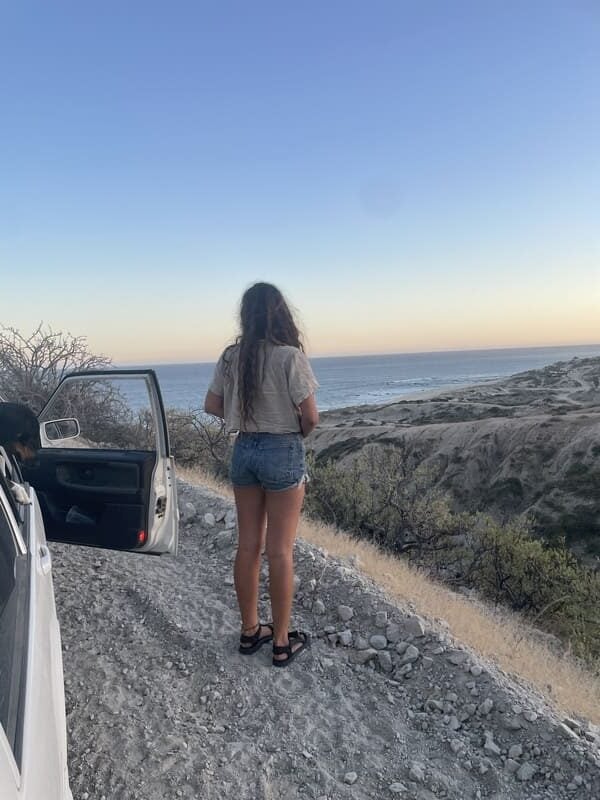
Photo: Audy Scala
Avoiding Crowds & Saving Cash (Late October or May)
I LOVE travelling in shoulder seasons, and here they’ll be your friend too. Shoulder season is your sweet spot if you want to dodge the price hikes and crowds but still catch decent weather. Places like Ensenada, Loreto, or La Paz are quieter, hostels are easier to book, and you’ll still have access to most of the good stuff—just maybe not peak wildlife or surf. May gets hotter fast, though, so it’s better suited to beach bums than hikers.
When to Think Twice (July to September)
Hot, humid, and sometimes stormy—especially in the south. This is hurricane season, so towns like La Paz, Cabo, or Todos Santos can get hit hard. On the upside, it’s low season, so you’ll find more budget Baja hotels and fewer people. If you can handle the heat and stay flexible, it’s doable. Just don’t expect much action inland unless you like sweating through your backpack.
What to Pack for Baja
Unfortunately, packing for Baja isn’t as cut and dried as other places in Central America. Parts of the trip will most likely involve wind, water, sun, and major temperature fluctuations – all in the same day. This makes packing for Baja hard, especially if you’re trying to pack light.
As a rule of thumb, I would check the season that you’re visiting Baja in, the activities you want to do, and the bag you’re taking and go from there. Of course, traveling in a van gives you more means to overpack shit than hitchhiking with a 30L backpack!

Photo: Audy Scala
If you’re heading out during hurricane season, it’s always a good idea to pack a good rain jacket. My favourite is the Patagonia Torrentshell jacket. It saved me from getting saturated so many times!
If you have your own snorkel, throw it in as it’ll save you money on renting them, and it’s just always nice to use your own, right?
Ear Plugs
Snoring dorm-mates can ruin your nights rest and seriously damage the hostel experience. This is why I always travel with a pack of decent ear plugs.
Hanging Laundry Bag
Trust us, this is an absolute game changer. Super compact, a hanging mesh laundry bag stops your dirty clothes from stinking, you don’t know how much you need one of these… so just get it, thank us later.
Sea To Summit Micro Towel
Hostel towels are scummy and take forever to dry. Microfibre towels dry quickly, are compact, lightweight, and can be used as a blanket or yoga mat if need be.
Monopoly Deal
Forget about Poker! Monopoly Deal is the single best travel card game that we have ever played. Works with 2-5 players and guarantees happy days.
Grayl Geopress Water Bottle
Always travel with a water bottle! They save you money and reduce your plastic footprint on our planet. The Grayl Geopress acts as a purifier AND temperature regulator. Boom!
Getting in and out of Baja
Getting in and out of Baja as a backpacker depends on where you’re coming from. Luckily, whether you’re flying internationally, coming from the mainland or driving down from the US, getting into Baja is pretty damn accessible.
From the U.S. (Northbound or Southbound)
Most backpackers cross overland at Tijuana–San Diego, the busiest land border in the world. It’s fast to cross on foot, cheap to bus onward from there, and easy to jump into Baja California. Other crossings like Mexicali or Tecate are quieter and more laid-back if you want to avoid the Tijuana chaos, but may not be as organized.
By Air:
The main airport hubs are Tijuana (TIJ) in the north, and La Paz (LAP) or San José del Cabo (SJD) in the south.
Tijuana is great if you’re flying domestically or using the Cross Border Xpress (CBX) footbridge from San Diego airport—super handy and cheaper than flying directly into Mexico.
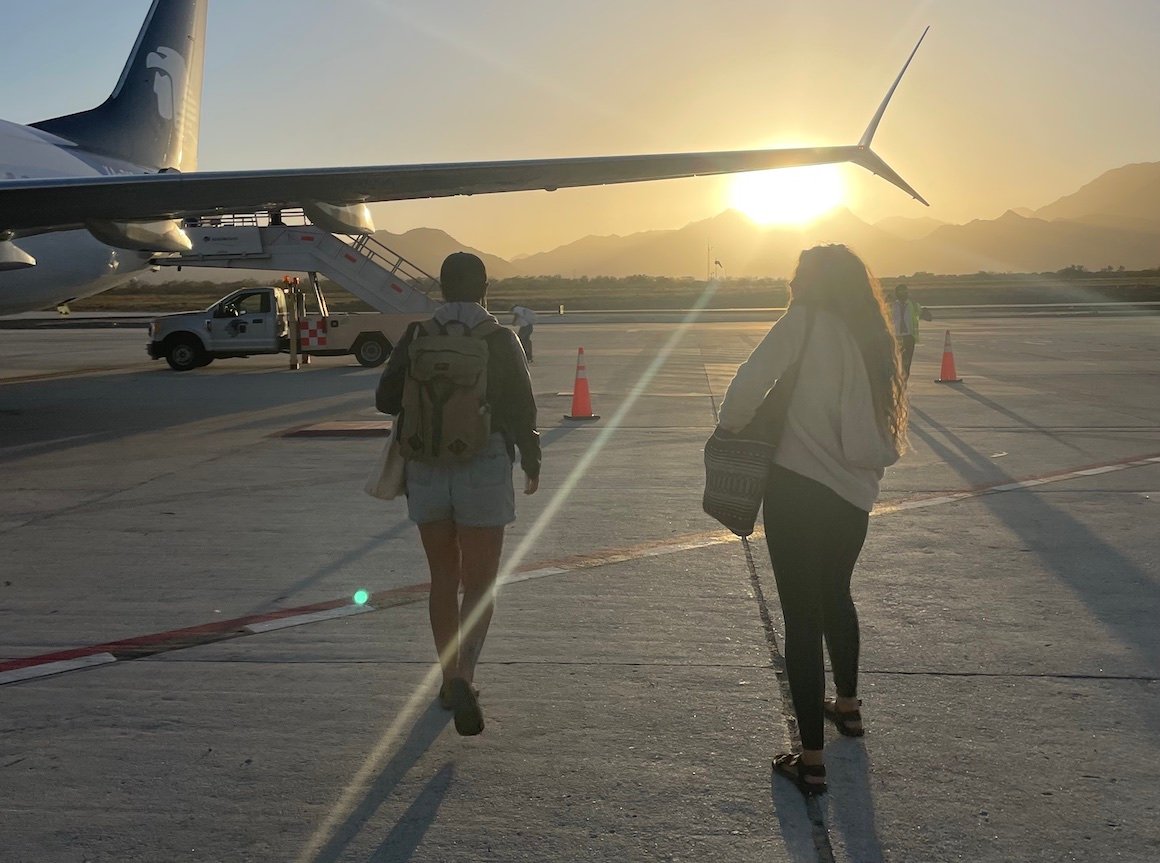
Photo: @audyscala
La Paz and Los Cabos serve more domestic and international flights. Cabo’s airport has significantly more connections to the US and other international destinations than La Paz, but it comes with tourist prices.
Ferries (to/from Mainland Mexico):
You can cross the Sea of Cortez to the mainland from La Paz, with ferries going to:
- Mazatlán (longer but more popular with backpackers—cheaper and more scenic)
- Topolobampo (closer but a bit dull unless you’re heading inland fast)
The ferry isn’t dirt cheap ($60–100 USD for foot passengers), but it’s a solid overland option and can save you from backtracking the whole peninsula. Book a few days in advance in high season, especially if you want a cabin.
Buses:
If you’re crossing back into mainland Mexico or the U.S., long-distance buses like ABC and Aguila can take you from La Paz all the way to Tijuana (or vice versa), with stops in every major town. It’s a long haul—expect 24+ hours end to end, so make sure you stock TF on snacks! Time aside, the buses are decent and the journey isn’t so traumatic, all things considered.
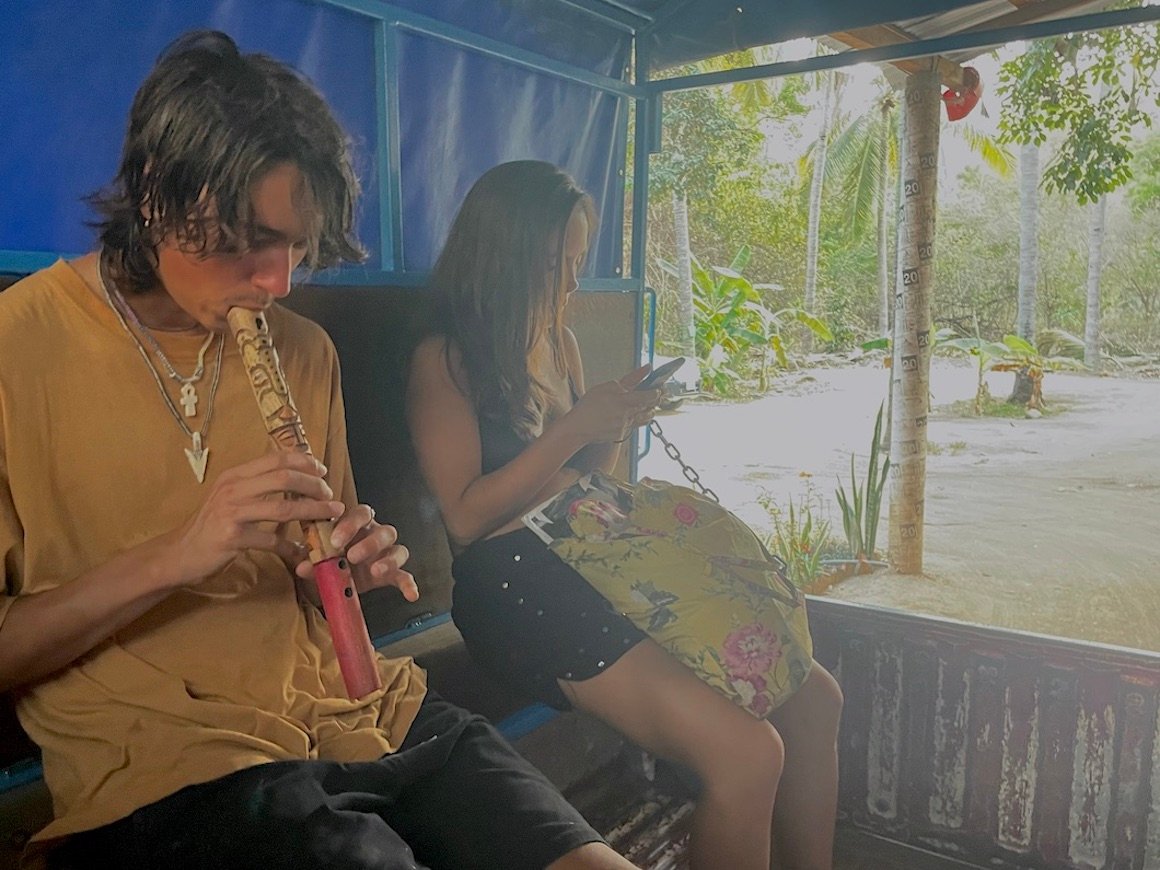
Photo: @audyscala
Traveling around Baja
Traveling around Baja takes patience and a bit of flexibility—it’s a long, skinny peninsula with big gaps between towns and limited public transport, but it’s doable if you plan smart.
Buses
Long-distance buses like ABC, Aguila, and Elite cover most of the major towns—Tijuana, Ensenada, Guerrero Negro, Loreto, La Paz, and Cabo. They’re reliable, clean, and safe, but they’re not cheap and not particularly frequent, so patience is needed here. Overnight buses can save on hostels, but don’t expect ultra-budget prices like in mainland Mexico or the snazzy kind of sleeper buses you get in parts of Southeast Asia.
Local transport
In smaller towns, colectivos (shared vans or pickup trucks) are hit or miss. Some routes run regularly (like La Paz–Todos Santos–Cabo), but others are rare or nonexistent. If you’re heading to remote beaches or villages, it’s usually hitchhiking, renting a car, or hoping for a lift. Hopefully, the Baja gods are looking down on you that day!
Hitchhiking
Common and relatively safe in Baja, especially along Highway 1. Locals, tourists, and truckers all pick up travelers, but you’ll wait longer in the desert stretches and should always carry water.

Car rentals
Not a budget move, but splitting a car or van rental with other travellers opens up the good stuff with none of the faff—camping spots, hidden beaches, and off-grid towns that buses don’t go through.
Cycling or vanlife
A lot of travelers bikepack or drive vans down the peninsula. If you’ve got the gear and time, it’s one of the best ways to explore at your own pace.
Basically: Baja’s big, empty, and not built for fast travel, but if you take it slow and stay flexible, you can make it work on a budget without too much stress.
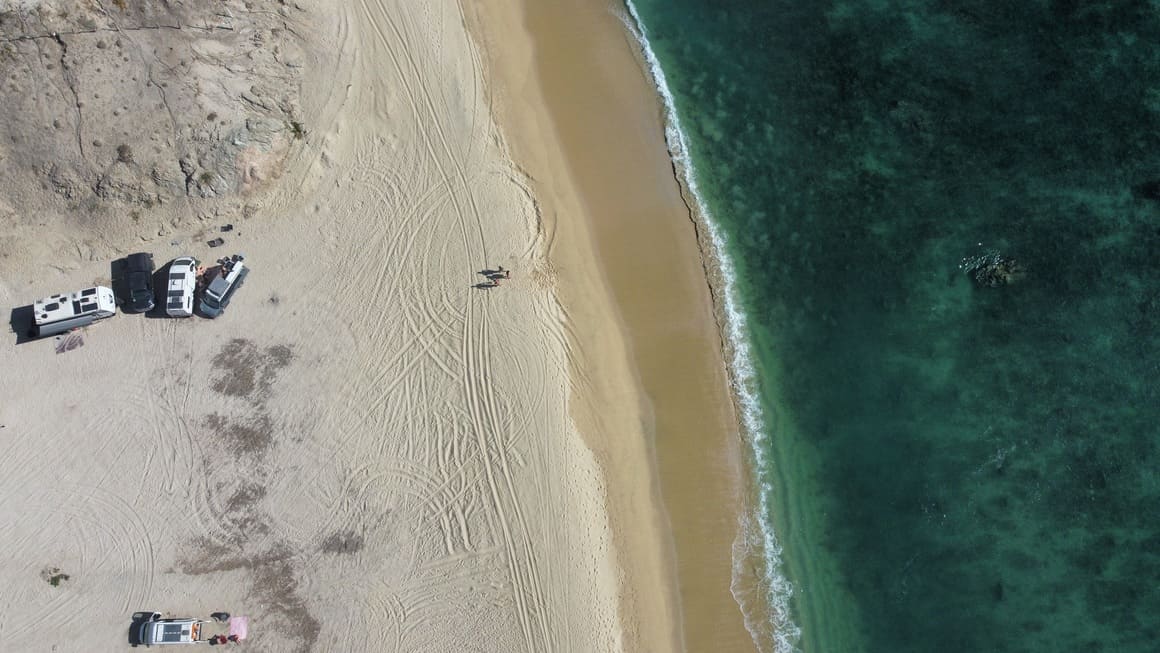
Photo: Audy Scala
Staying Safe in Baja
Staying safe in Baja as a backpacker mostly comes down to common sense and knowing what you’re getting into. It’s not the cartel war zone the headlines love to hype up, especially not along the usual backpacker route.
Cities like La Paz, Loreto, Ensenada, and even Tijuana (as long as you stick to central areas) are used to travelers. Petty theft is a bigger concern than anything serious, so don’t flash your gear or leave stuff lying around on the beach.
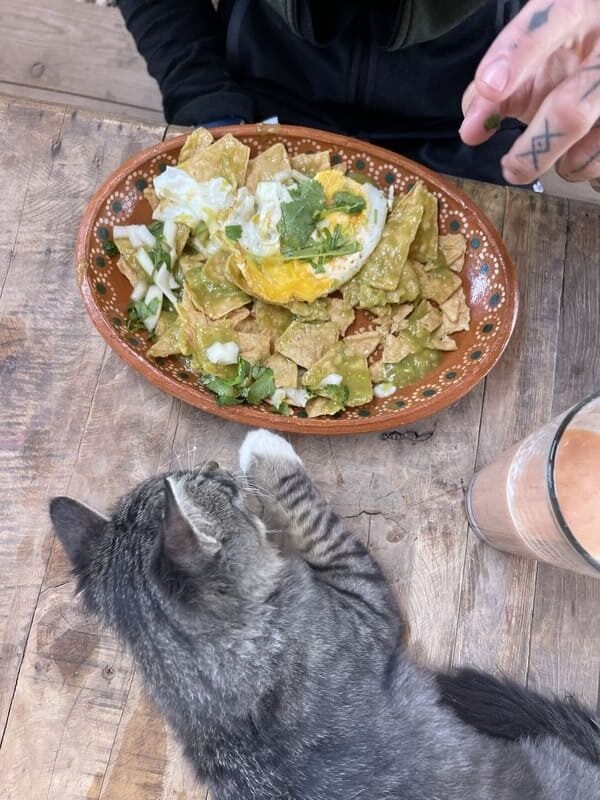
Photo: Audy Scala
If you’re hitchhiking or road-tripping, the real risk is getting stuck in the middle of nowhere without cell service. Always carry water, snacks, and let someone know where you’re headed if you’re going off-grid.
Night travel is best avoided – highways are dark, remote, and full of cattle, potholes, and the occasional rogue truck. I’m not saying don’t do it, just make sure you’re confident enough in your driving abilities and the car/van you’re in for some potentially sketchy road sitches. Buses are usually fine, but if you’re hitchhiking or driving, stick to daylight hours.
Military checkpoints are normal on Highway 1. They’re usually easygoing and just want a quick look in your bag or vehicle. Corruption happens more with drivers than backpackers on foot.
As for nature, you’re more likely to get stung by a jellyfish or sunburned to hell than anything else. Shuffle your feet for stingrays and ask locals about currents before swimming.
Plenty of people backpack Baja solo without problems, including solo women. Trust your gut, avoid sketchy spots when camping, and link up with others when you can. Baja has its rough patches, but it’s not out to get you. Stay sharp, travel smart, and you’ll be just fine.
Travel Insurance for Baja
Unfortunately, things can go wrong when you least expect them. That’s why good travel insurance is essential before hitting the road to Baja.
ALWAYS sort out your backpacker insurance before your trip. There’s plenty to choose from in that department, but a good place to start is Safety Wing.
They offer month-to-month payments, no lock-in contracts, and require absolutely no itineraries: that’s the exact kind of insurance long-term travellers and digital nomads need.
SafetyWing is cheap, easy, and admin-free: just sign up lickety-split so you can get back to it!
Click the button below to learn more about SafetyWing’s setup or read our insider review for the full tasty scoop.
Working and Volunteering in Baja
Working legally in Baja as a backpacker is next to impossible unless you’ve got a visa that says otherwise. Mexico doesn’t do casual tourist work permits, and getting caught working under the table—especially in tourist zones—can lead to fines, deportation, or worse. That said, volunteering is a different story and way more common.
Plenty of hostels, surf camps, eco-projects, and even ranches will trade a bed (and sometimes meals) for a few hours of cleaning, front desk work, or helping with guests. The usual suspects like Workaway or Worldpackers list a bunch of options across Baja—from beach hostels in La Paz to permaculture setups in the mountains.

Photo: Will Hatton
It won’t be glamorous or earn you any money, but if you want a way to stretch your budget, a spot to sleep and some community for a bit of slow traveling, it’s definitely worth doing a bit of research into.
FAQs About Backpacking Baja
Before you come to Baja, you’re likely to have a few burning questions. Luckily, I’ve got answers!
Final Advice Before Visiting Baja
Baja’s not the easiest place to backpack, but that’s part of what makes it special. It’s raw, open, and feels miles away from the more polished parts of Mexico. You’ll deal with long bus rides, patchy info, and the occasional detour—but you’ll also get unreal sunsets, wild ocean moments, and the kind of freedom that’s harder to come by these days: no crowds, just space to explore at your own pace.
So take your time, keep it loose, and don’t stress if plans go sideways. If you’re up for a bit of unpredictability, Baja tends to give back more than it takes.
Use this guide to keep your pesos in check, dodge the obvious mistakes, and make the most of a region that still feels untamed. Baja’s got a way of rewarding anyone willing to go a little off-script.
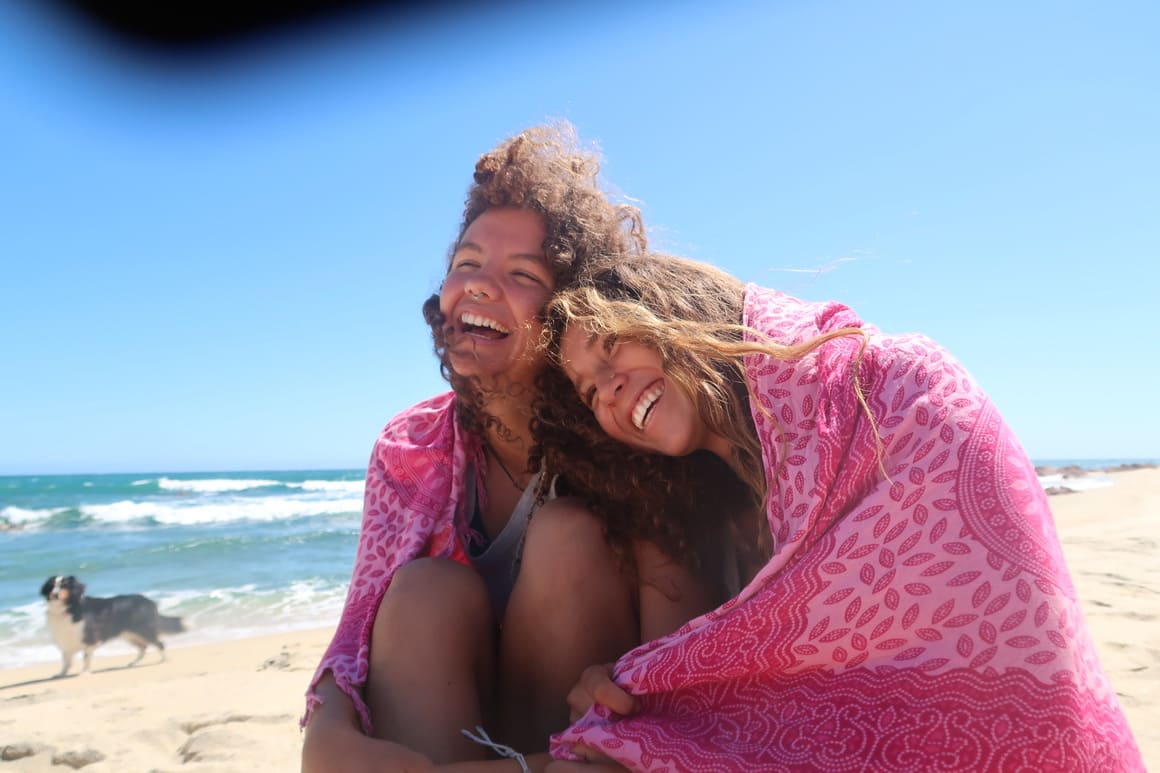
Photo: Audy Scala
- Check out all the best places to visit in Mexico City for planning the most dope trip.
- We’ve also got where to stay in Mexico covered with our epic guide.
- You’ll also wanna stay in the best hostels in Baja too!
- Sort out your travel insurance for Mexico before your trip.
- Get your international sim card for Mexico organised to avoid hassle.
Buy Us a Coffee!
A couple of you lovely readers suggested we set up a tip jar for direct support as an alternative to booking through our links, since we’ve decided to keep the site ad-free. So here it is!
You can now buy The Broke Backpacker a coffee. If you like and use our content to plan your trips, it’s a much appreciated way to show appreciation 🙂



